V. Looking baaA-ck
Hidden Villa turns 100, pg. 17





September 2023 Volume 25 Issue 1
Editors-in-Chief
Felicia Buchholz
Austin Eng
Asha Kulkarni
Nadia Soberg
Anna Van Riesen
A sheep peers through a fence at Hidden Villa farm in a photo taken by photographer Kensie Pao. Hidden Villa has a rich history of education and inclusivity and will celebrate its 100th anniversary next year, looking both back at the past and forward into the future.
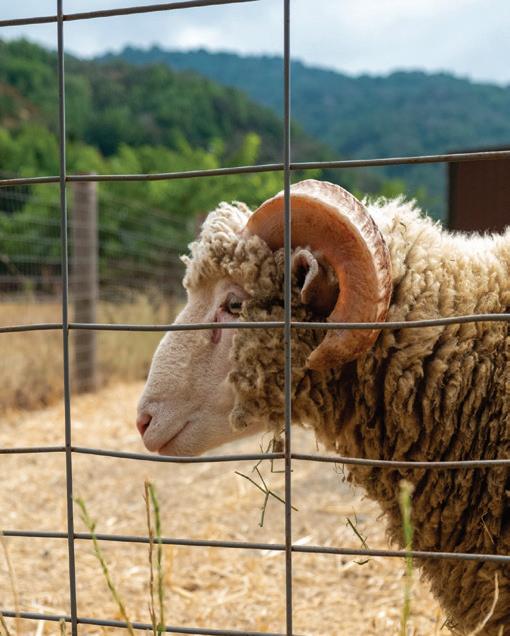
Publication policy
Verde Magazine, a news and features magazine published by the students in Palo Alto High School’s Magazine Journalism class, is a designated open forum for student expression and discussion of issues of concern to its readership. Verde is distributed to its readers and the student body at no cost.
Letters to the editors
The staff welcomes letters to the editors but reserves the right to edit all submissions for length, grammar, potential libel, invasion of privacy and obscenity. Send letters to verdemagazine1@gmail. com or 50 Embarcadero Rd Palo Alto, CA 94301.
Advertising
The staff publishes advertisements with signed contracts providing they are not deemed by the staff inappropriate for the magazine’s audience. For more information about advertising with Verde, please contact our business manager at verdebusiness5@ gmail.com.
Printing & distribution
Verde is printed five times a year in September, November, February, April and May by Folger Graphics in Hayward, California. The Paly Parent Teacher Student Association mails Verde to every student’s home. All Verde work is available at verdemagazine.com
Features Editor
Lizzy Williams
Profiles Editors
Lia Cardwell
Otto Kiss Meyerfreund
Culture Editors
Divya Gandhi
Cate Graney
Perspectives Editor
Vit Do
News Editor
Alma Bendavid
Launch Editor
Ella Hwang
Copy Editors
Lia Cardwell
Lizzy Williams
Business Manager
Maya Rajbhandari
Social Media Managers
Chloe Huang
Sophie Mies
Art & Design Director
Jeslyn Chen
Photographer
Kensie Pao
Staff Writers
Eva Chang
Augustus Soedarmono
Guest Writers
Ashray Gupta
Carissa Tsui
Guest Artists
Talia Boneh
Sabela Chelba
Sasha Kapadia
Sophie Pan
Kiara Tavakoli
David Tomz
Charlie Wang
Adviser
Paul Kandell



From the moment we take our first steps, we’re taught to move forward. However, amidst the constant worry about what the future may hold, making an effort to look behind us is equally important, as it reminds us of how far we have come.
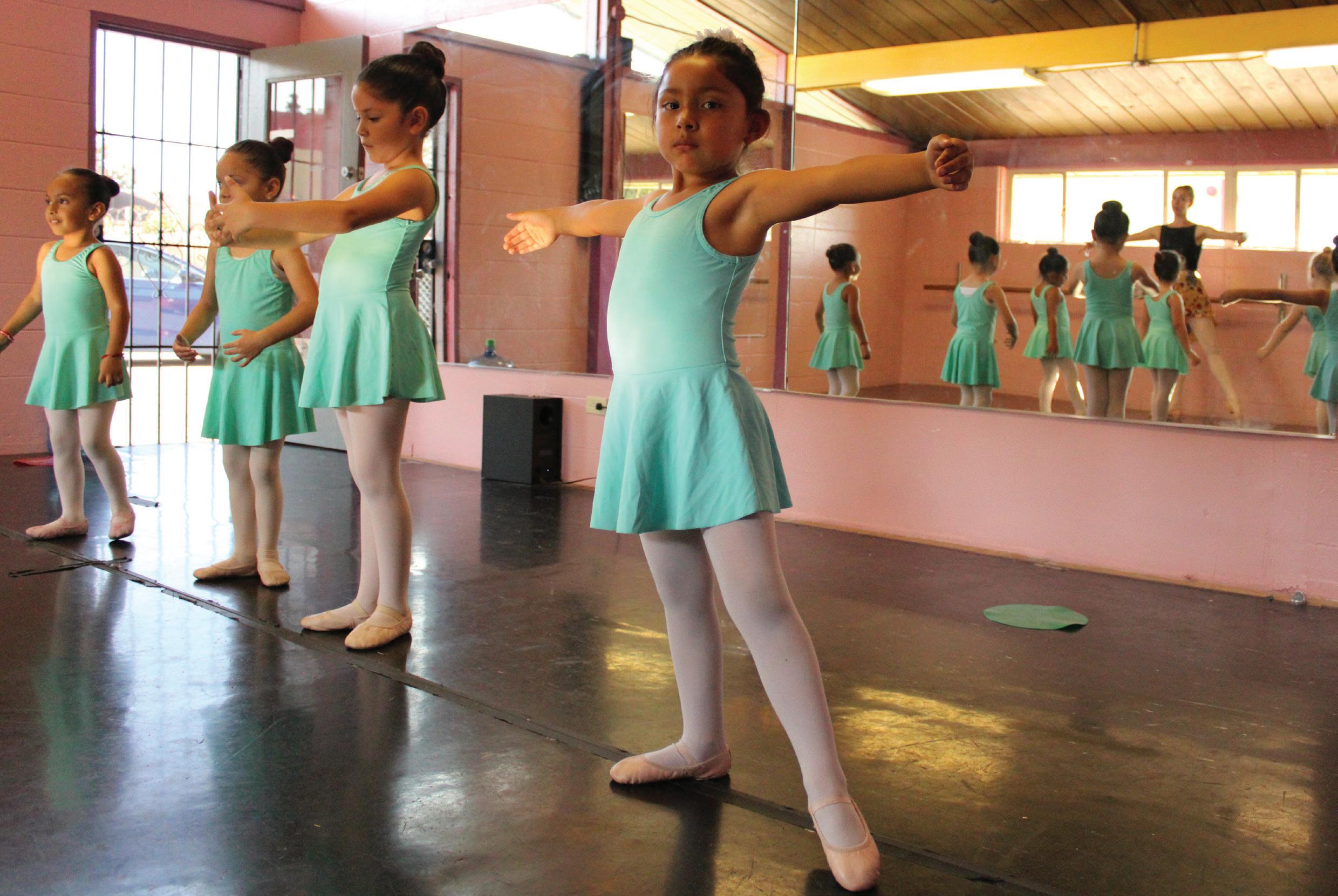
Pausing to take a quick glance back in time can bring us surprisingly peaceful and ordinary moments, such as watching farm animals roam the idyllic pastures of Hidden Villa. Visiting this farm in Los Altos Hills is a nostalgic childhood memory for many students. Almost 100 years earlier, animals and children explored these same Hidden Villa fields during summer camps meant to promote inclusivity and diversity — efforts that continue in a much different world today.
This year’s first Verde edition highlights both the past and the future of institutions like Hidden Villa, including long-standing places, people, and landmarks.
In “Hidden history,” Art and Design Director Jeslyn Chen and staff writer Maya Rajbhandari examine how Hidden Villa has stayed true to its original mission while expanding its impact on the local community.
Historical landmarks lie closer to home as well. When search-
ing for an example of reinvention, look no further than Palo Alto High School’s 105-year-old Tower Building. In the photo essay, “Construction continues,” staff writer Chloe Huang details the structure’s massive renovations, which will be completed in December.
For some local businesses, survival can be a struggle, even after almost three decades of serving the community. Staff writers Augustus Soedarmono and Huang explore how the Palo Alto community came together to fight against the eviction of Mike’s Diner Bar, a beloved Midtown restaurant, in “Escaping eviction.”
As the school year opens, we too can reflect on the past as we journey forward. In our first issue, we welcome both new and returning staffers. This year, we hope to draw on Verde’s long tradition of in-depth reporting while capturing new developments around us.
When reading this issue, we hope that you, just like the sheep in the Hidden Villa pasture, will take a long look baaa-ck.
THIS SPRING, the United States Food and Drug Administration approved the first prescription naloxone nasal spray — a product more commonly known under its brand name, Narcan. The life saving drug is used to reverse opioid overdoses, and has generated excitement throughout the country amid a rise of opioid overdose deaths.

In the past two years in the US, teen overdose deaths linked to opioids have tripled, according to Santa Clara County Behavioral Health Services. Additionally, there have been 639 overdose deaths in the past five years in Santa Clara County, 416 of which involved fentanyl, an opioid 100 times stronger than morphine. A fatal overdose on fentanyl can be caused by only a few grains. While many students don’t actively seek out fentanyl, their lives can be endangered when other drugs, such as marijuana or cocaine, are laced with it.
“It [Narcan] should be able to be accessed in all classrooms because you never know when someone will overdose,” sophomore Sophie Oshige said. “You never know when you need to save a life.”
To use Narcan, training is recommended by health professionals. Rosemarie Dowell, the district’s Health and Services Coordinator, agrees that student Narcan training would provide increased protection from student drug overdoses.
“The more people that are aware, observe and act more quickly … will save more lives,” Dowell said.
Narcan is a small pre-packaged nasal spray that can be easily carried around. According to the Prescription Drug Abuse Policy System, all 50 states and the District of Columbia have enacted legislation that “encourage its use by individuals in a position to assist a person experiencing a drug
Verde commends PAUSD’s implementation of staff training for Narcan in March after receiving Narcan kits from Santa Clara County and adopting a policy to have Narcan on campus.
“It [the training] went really well,” Dowell said. “There was definitely over 100 [participants] … from all school sites.”
Dowell said that teaching students to administer Narcan is important because it could help to mitigate drug-related injuries
“We would prefer that people [students] don’t use drugs,” Dowell said. “[You] don’t know what you’re getting when you’re getting stuff [drugs] from other people, or on the streets, or strangers, even friends sometimes … knowing how to use Narcan can save lives, and that’s just huge.”
According to Dowell, while the district has some interest in establishing a student Narcan training program, the best way to implement it is unclear.
With possible Narcan training for students in discussion, Dowell said that the training would highlight the risks of drug use, especially drugs from an unknown source, and more importantly how students can talk to friends about the risks of drug use.
“You may not personally be doing drugs, [but] you may know somebody who’s doing drugs,” Dowell said, “How you approach that and try to support them to not do that, to keep them safe [is important].”
For the sake of student safety, PAUSD needs to take action to educate the entire Paly community about the dangers of opioids and how to prevent overdoses, not just staff. v
People that are aware, observe and act more quickly... will save more lives.”
— ROSEMARIE DOWELL, Palo Alto Unified School District Health and Services Coordinator
SINCE THE COVID-19 PANDEMIC BEGAN, the number of people receiving the influenza vaccine has steeply declined, according to the United States Centers for Disease Control and Prevention. The pre-pandemic flu vaccination rate in youth was 62.2%, but by the 2022-2023 season, only 55.1% of children had received the vaccine.

Making flu vaccines available to students and staff on campus, similar to the distribution of COVID-19 vaccines at Palo Alto High School in 2021, would likely decrease the prevalence of the flu virus on campus. Verde urges the Palo Alto Unified School District to provide on-campus flu vaccinations to improve access for students.
Other districts have seen success in similar programs: Oakland Unified School District distributed free flu vaccines to students and staff on campuses every fall between 2014 and 2019. The program, Shoo the Flu, partnered with the Alameda County Public Health Department and the Oakland Unified School district to administer nearly 45,000 vaccines.
PAUSD Health Services Coordinator Rosemarie Dowell said that comfort is influential in convincing someone to receive a vaccine.
“It [if the vaccination clinic] is in a location that people know and they’re familiar with … that cuts down on some of the anxiety if they are nervous about getting shots,” Dowell said.
Usually, children in the U.S. get vaccinated at their pedi-
atrician’s office, a location children visit much less frequently than school. Not only is providing the flu shot on campus more convenient, but students will be more comfortable because they know the environment there.
“I definitely think convenience is always super helpful in encouraging vaccination,” Dowell said. “That was why we decided to hold the COVID vaccine clinics at Paly.”
The precedent of hosting COVID-19 vaccinations might even make it easier for Paly to reimplement the same system for flu vaccines.
“We’ve even continued to discuss that with Safeway, who had partnered with our COVID vaccines too,” Dowell said. “It’s just [a matter of] coming up with the best plan to offer the vaccines for good utilization.”
According to Sutter Health, people who are 17 or younger need parent or guardian consent before receiving a vaccine in Palo Alto. Paly can work with a provider like Safeway or Stanford who has an established consent system so Paly can rely on these providers’ expertise and knowledge. The COVID-19 vaccines that were previously given out on campus would make it easier for Paly to provide flu shots on campus because they could use the same structure.
“It [offering flu shots on campus] is definitely not off the table,” Dowell said. “As a health services coordinator, I really value making health services accessible as possible to students.”
So do we. Flu shot availability on campus — and by extension, student health — is something to push for. v
Art by SABELA CHELBA[If the vaccination clinic] is in a location that people know … that cuts down on some of the anxiety if they are nervous about getting shots.”
— ROSEMARIE DOWELL, Palo Alto Unified School District Health and Services Coordinator
 Commissioner Hannah Jensen
Commissioner Hannah Jensen

Will anything be different about Spirit Week this year?
We’re adding more relay races into the rallies and we’re bringing in new all-school cheers so we can unite the grades. Even though Spirit Week is kind of all about focusing on your grade and winning… we’re trying to bring more unity.
What are you looking forward to in Spirit Week?
I’m really looking forward to the games and seeing everyone dressed, up because I feel like this year the juniors and the seniors are a little bit more connected. The freshmen are actually insane this year. Everything just seems more enhanced, and I’m really excited to see what people do for each day. We’re headed in a good direction to bring the spirit back to Paly.
“My favorite thing is definitely doing the chants. I just think the Class of 2024 has such a cool one, and we were able to come up with rhymes that’s not just ‘four’ with ‘for’.”
— Tate Hardy“Coming back from COVID as a rising sophomore, my peers and I really had no idea what spirit week was like. When we finally experienced it at that first rally, the feeling was unlike any other.
 — Evelyn Zhang
— Evelyn Zhang
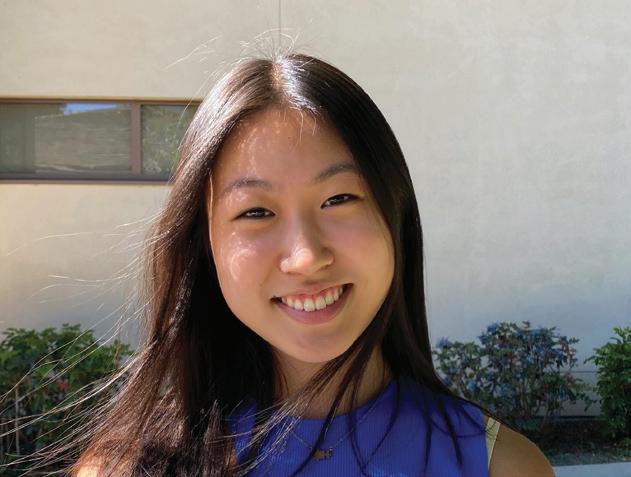

illicit affairs
by Taylor SwiftI know it won’t work by Gracie Abrams
Reflecting Light by Sam
PhillipsFuneral by Phoebe
The Other Woman by Lana
the way things go by beabadoobee Say You Love Me by Fleetwood Mac Sweater Weather by The Neighbourhood
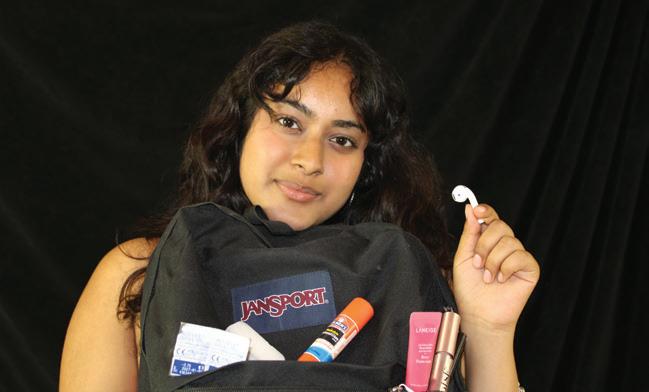
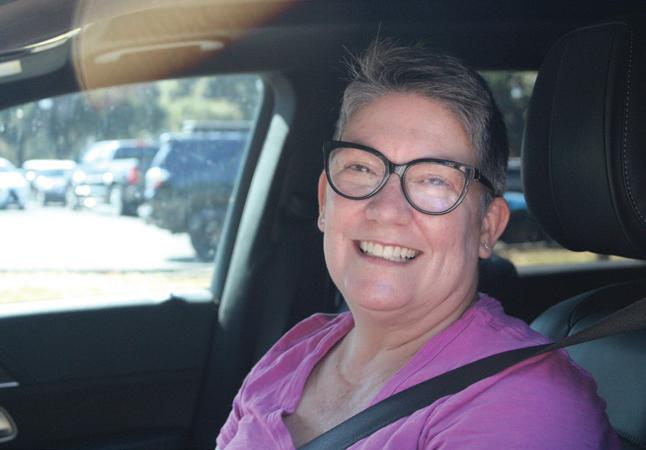
Q: How long do you have to wait here?
A: About 10 minutes
Q: What are your opinions on the Paly car pickup system?
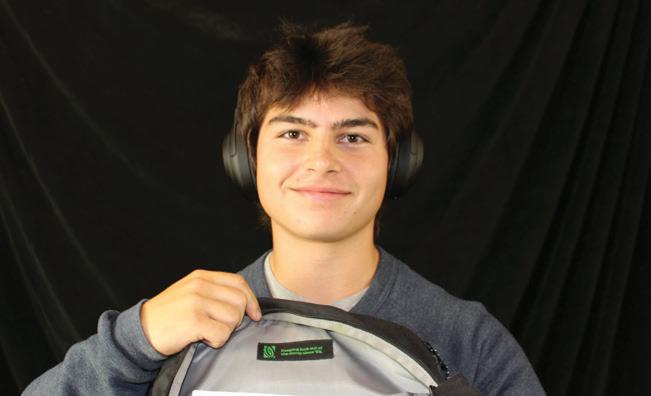


A: It seems a little slow, but there’s also not a lot of people picking up their kids, so it’s not bad at all. It’s just safer to come to the front.
Q: How long do you usually have to wait?
A: I normally come around 15 minutes before [school ends] ... It seems a little unsafe for the kids because ... sometimes they’re intermixing with the cars and if the cars are going fast, that could be dangerous.
Q: How long do you have to wait?
A: I usually get here about 15 minutes before she [my daughter] gets out.
Q: What are your opinions on the pickup system?

A: I still haven't really figured [it] out... but I see people lined up here so I'm doing the same thing.
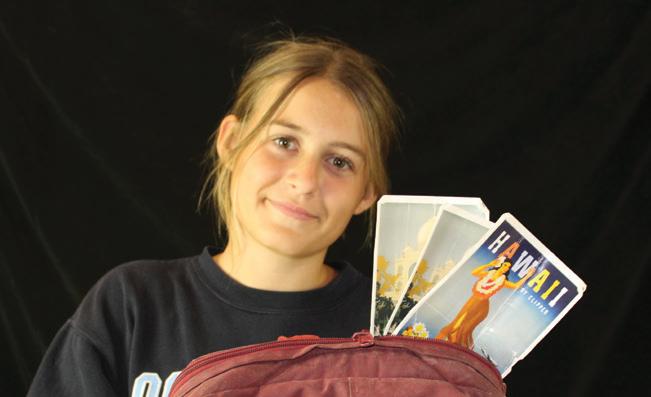
“What’s in your backpack?” verde’sHeather Groden Mark Stevens Jaime Teper William Hickey, junior Saanvi Garg, senior Britney Williams, sophomore Bridgers Del Rey Photos by Chloe Huang lip balm, AirPods, mascara, glue Trader Joe’s snacks, portable fan Savannah Taylor, sophomore spray sunscreen, “thank you” cards
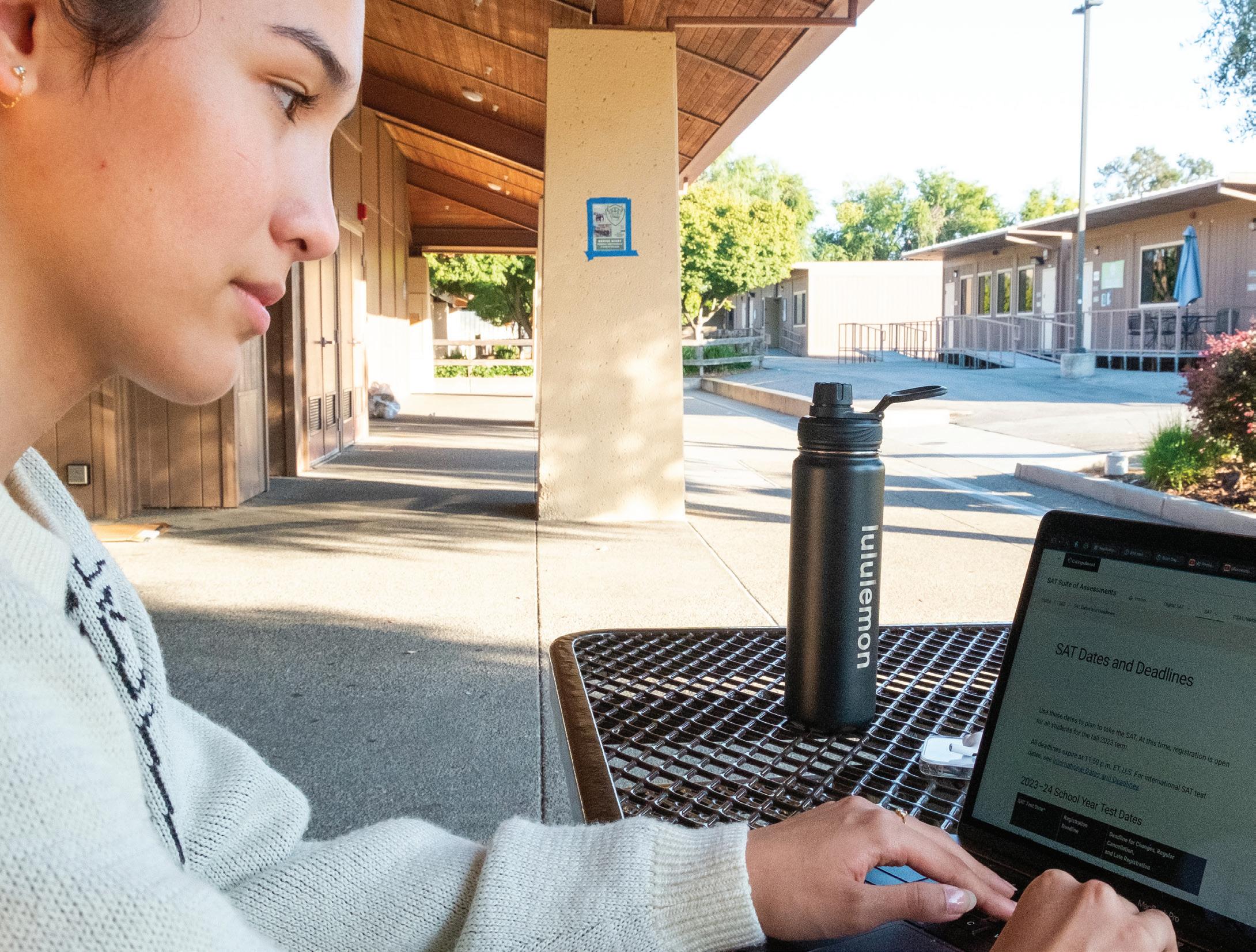
THE COLLEGE BOARD IS transitioning to digital SAT, PSAT and AP tests this year nationwide in order to increase accessibility.
The first Palo Alto High School senior digital SAT and junior digital PSAT are occurring on Oct. 11. In addition, starting this March, all SATs and PSATs will be strictly digital. According to the College Board website, the digital SAT will be considerably shorter at around two hours total with adjustments made to the English and the math sections compared to the
traditional three hour test.
The College Board will, however, still offer traditional pen and paper AP tests for all subjects, and is piloting the digital AP tests this spring such as the in AP Computer Science Principles, AP English Language and Composition, AP English Literature and Composition, AP Seminar and AP U.S. History, that will all be offered at Paly.
Some students are excited for the new digital format and believe that it could help improve performance.
“I didn’t like the paper SAT and I kind
of want to try something new,” junior Stefan Sochacki said.
Other students intend to take the paper test as soon as possible in an attempt to avoid the digital version.
“I just wanted to have a good understanding of what exactly would be on the test because I didn’t know if the digital one would have different variations and questions,” junior Sasha Kapadia said. “There are more resources available to me for the paper one compared to the digital one.”
by VIT DOTHE AP LANGUAGE AND composition classes at Palo Alto High School are transitioning to a gradeless format for all assesments, while still reciving semester and quarter grades.
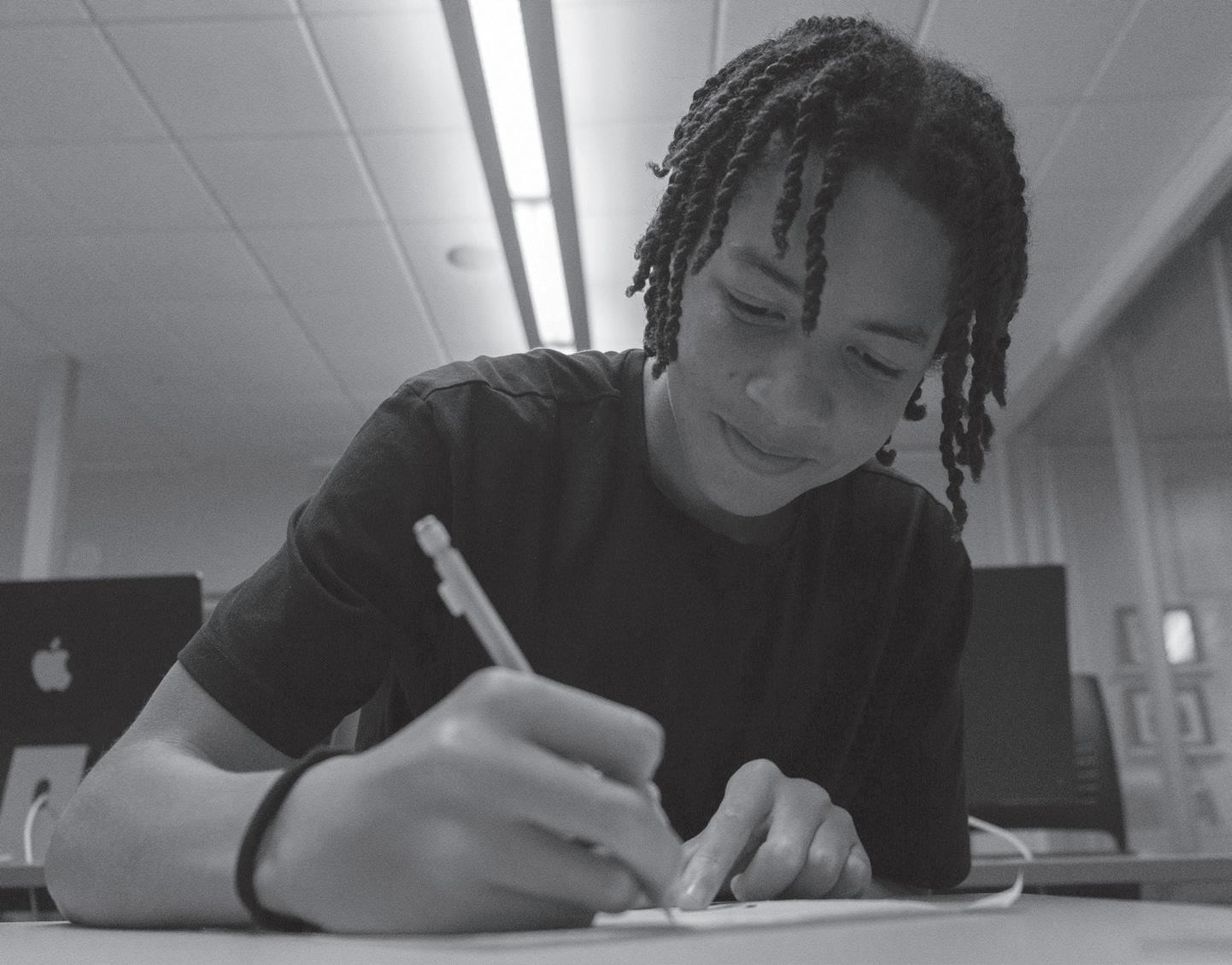
According to the course guide for AP Lang all assignments will be assesed on a rubric based on learning progression as opposed to any number or letter grade.
Semester grades will be determined during monthly grade conferences discussing how the student has progressed in the course goals over the course of the semester.
Due to extensive research in books like “Ungrading” by Susan Blum, the AP Lang teachers have found that students learned better when assignments and assessments were gradeless and students recived feedback only.
As this policy is very new to all the teachers, the AP Lang teachers declined to comment on the new grading policy at this time to prevent confusion and misinformation about the new grading system.
Junior, Tyler Kramer belives the new policy is helpfull. “I think it’s gonna motivate children, kids to students to give their full effort” Kramer said.
by AUGUSTUS SOEDARMONOANEW EDUCATOR HOUSING project, had a ceremonial groundbreaking on 231 Grant Ave. last month and aims to deacrese commute time for teachers.
The educator housing project, first proposed by Santa Clara County Supervisor Joe Simitian, has a total of 110 units located across the street from the Palo Alto Courthouse, built specifically for educators in the Bay Area. The constrction started Aug. 22 and is scheduled to finish in 2025.
This includes Palo Alto Unified School
District, Los Altos School District, Mountain View Whisman, and Foothill-De Anza.
“Right now we have teachers and other school staff who are commuting vast distances to get to and from their jobs at school every day,” Simitian said. “This is time that is not spent preparing lesson plans, it is time that a teacher is not available to meet with a student before or after school to help.”
Simitian additionally stressed the loss that this commute brings to students.
“So, you know, in a very real sense, these long distance commutes are robbing Palo Alto students of the benefit of having teachers ... to help them,” Simitn said.
Another reason Simitain believes that this housing is crucial is that it helps teachers have a better conception of the daily life of their students.
“When teachers and staff members live in the community where they work, they have a better understanding of the community and the pressures and circumstances that their students live with and are subjected to every day,” Simitian said.
by ELLA HWANG“These long distance commutes are robbing Palo Alto students of the benefit of having teachers ... to help”
— JOE SIMITIAN, Santa Clara County Advisor
PALO ALTO HIGH SCHool is implimenting a new tardy policy this year aiming to reduce overall lateness to class.
According to this year’s Student Handbook, teachers are be ing encouraged to contact parents after students accumulate three or more unexcused tardies in one class.
DISCUSSING AND DEBRIFING —In groups, Palo Alto High School teachers discuss curriculum at the first Monday meeting held in the Media Arts Center. Deanna Chute, teacher on special assignment and member of California’s Multi-Tiered System of Support stresses the value of collaboration small groups like this. “Monday was sort of the culmination where we all as a staff came together and were basically debriefing, processing, and sharing out with others,” Chute said. Photo: Maya Rajbhandari
MONDAY MORNING MEETings for all Palo Alto Unified School District staff members are being introduced, providing staff more time for lesson planning, and students with a later start time.
According to an email sent out by JLS Middle School principal Chris Grierson, “the purpose of incorporating modified schedules is to allocate valuable time for staff development, training, planning, and collaboration. By doing so, we aim to enhance the overall learning experience for our students and ensure that they receive the best education possible”.
The new schedule aims to improve collaboration between teachers, and find out what students may need extra support.
“During new meetings, staff members [from] different departments can get together to work on various things,” assistant principal Jerry Berskson said.
Deanna Chute, a teacher on special assignment and member of California’s MultiTiered System of Support, adds on about the importance of these meetings.
“It’s about building a process that teachers can use all together with a consistent cadence
that feeds into a larger system,” Chute said. “The goal is about helping kids and supporting kids. How can we make sure they aren’t falling through the cracks?”
The first Monday meeting was held on Sep 18. Classes began at 10:15 a.m., and school ended at the usual 3:50 p.m. Topics discussed included teacher and student modifications that could improve the classroom environment, and ideas about integrating these interventions within the classroom.

During the meeting, teachers wrote down names of students who were “not doing well” or behind in their classes. If the same student came up more than twice, they would be assigned to an intervention team.
“Historically it’s been ‘I’m worried about this kid’ so I go and talk to a counselor,” Chute said. “Well can we do something more systematic so we really feel good about all the kids. The goal... long-term is to figure out how these teachers groups and meetings can fit into a larger schoolwide structure in a sustainable way where people are supporting and helping kids.”
by MAYA RAJBHANDARIThe handbook also states, “Students who accumulate tardies across multiple class periods will be assigned to a Study Hall intervention session with an Administrator.”
If students fail to attend the intervention sessions assigned to them, they will be banned from participating in any district-provided extracurricular activities until they attend a session.
The handbook also highlights the importance of attending class, “The Palo Alto Unified School District recognizes that success in school is in part related to prompt and regular classroom attendance.”
Some students believe this policy will be helpful toward their own learning and that of their peers, while others are angry at the stringency of the new policy.
Sophomore Surya Gannerkote expressed his opinion on the policy.
“It seems kind of excessive,” Gannerkote said.
On the other hand, senior Alice Lifshitz said she believes this policy will be beneficial for students.
“I feel like it is a good incentive to be more on time, and I noticed that I’m more on time to my classes,” Lifshitz said.
by OTTO KISS MEYERFEUNDIt’s about building a process that teachers can use all together.”
— DEANNA CHUTE, Teacher on Special Assignment and member of California’s Multi-Tiered System of Support

THE PALO ALTO UNIFIED School District is developing a new student support initiative to improve student academics and mental health for the 2023-2024 school year.
Multi-Tiered Student Support is a framework made to identify struggling students early to be able to support them with academics, behavioral, or social emotional learning. According to Assistant Superintendent Yolanda Conaway, MTSS is meant to identify students’ struggles early in the year.
“We can look at patterns from the year before to identify whether a student may be at a greater risk of having some difficulty in school,” Conaway said. “We want to be
able to support those students.”
Conaway said Palo Alto High School is establishing a student success platform that gathers data on students.
“[The] platform is the system that holds all the data from all over the place, even from some state assessments and universal screeners, and makes a profile of that student,” Conaway said. “Paly had access to that system already and they formed what’s called an MTSS leadership team.”
According to Conaway, once the system is fully developed, educators will be able to pull any student’ profile and see academics, behavioral issues or attendance.
But, according to Deanna Chute, Palo Alto High School math teacher and head
of the MTSS committee, the panorama database is not accessible to all teachers and educators at PAUSD yet.
“We are trying to make sure that everything is functioning in a way that is helpful and it needs to be meaningful to the staff to roll it out,” Chute said.
The goal of the MTSS is to get as much information about a student’s learning and use that information to see the root of any problem that may be occurring.
“The biggest win around MTTS is that we can find students who are struggling early and we don’t have to wait for a student to fail for us to do something about it,” Conaway said.
by SOPHIE MIES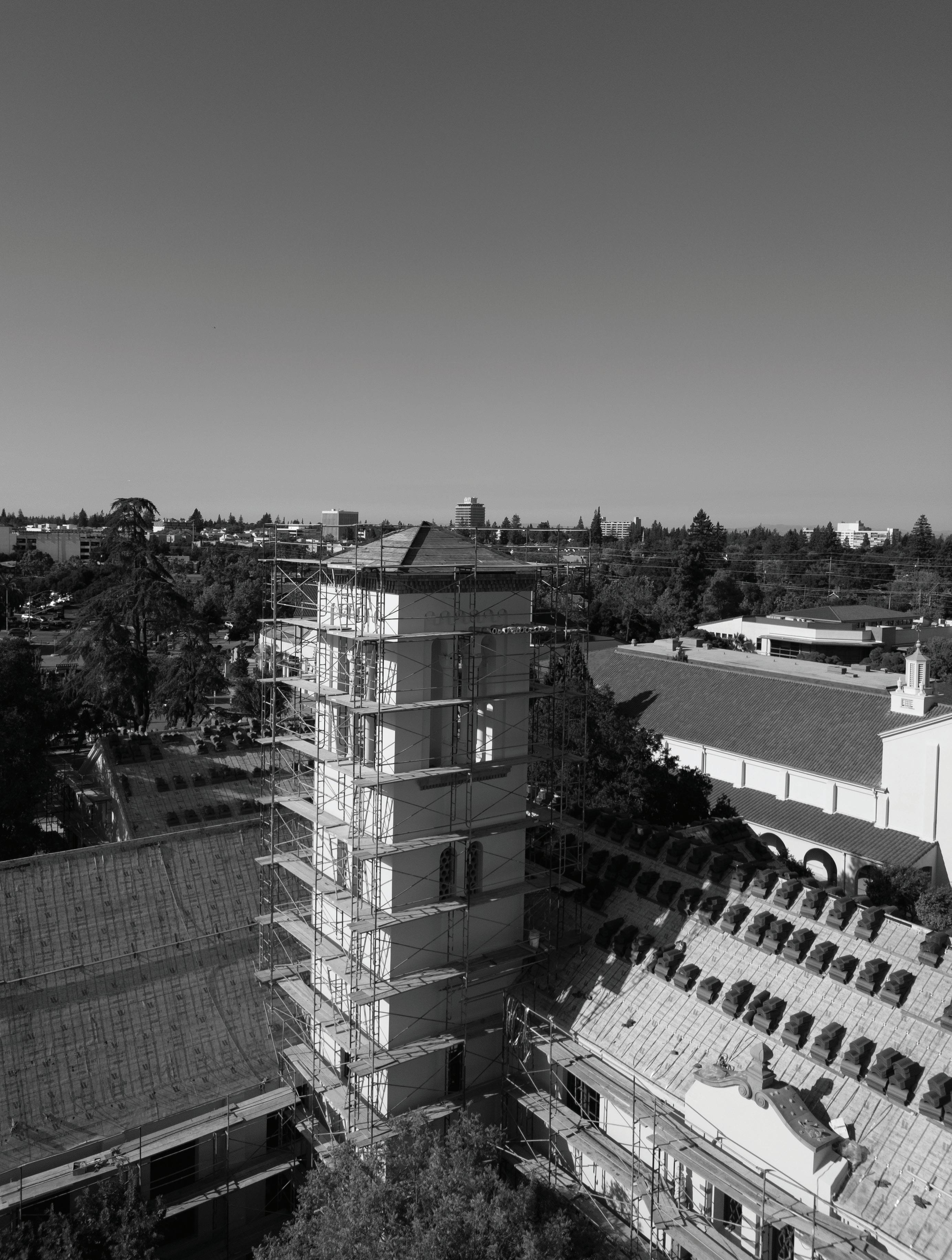
FOR THE THE THOUSANDS of students walking past Palo Alto High School’s Tower Building every day, hearing the constant sounds of loud construction, it is difficult to imagine what the fully modernized Tower Building will look like. With a new welcoming entryway, a spacious patio, a newly installed elevator and classrooms with updated technology, renovations on the Tower Building will finish in December.
According to Assistant Principal Jerry Berkson, construction began in December of last year, and due to how smooth the process has been and how most of the original framework is being kept, renovations are planned to finish earlier than expected.
Nevertheless, Berkson says the design and construction process has been complex.
“Every time we have a construction project, a committee is formed [by the school district] and we go over the needs and the wants,” Berkson said.

Juan Perez, a supervisor for the demolition company working on renovations, said that the school environment has also created challenges for construction.
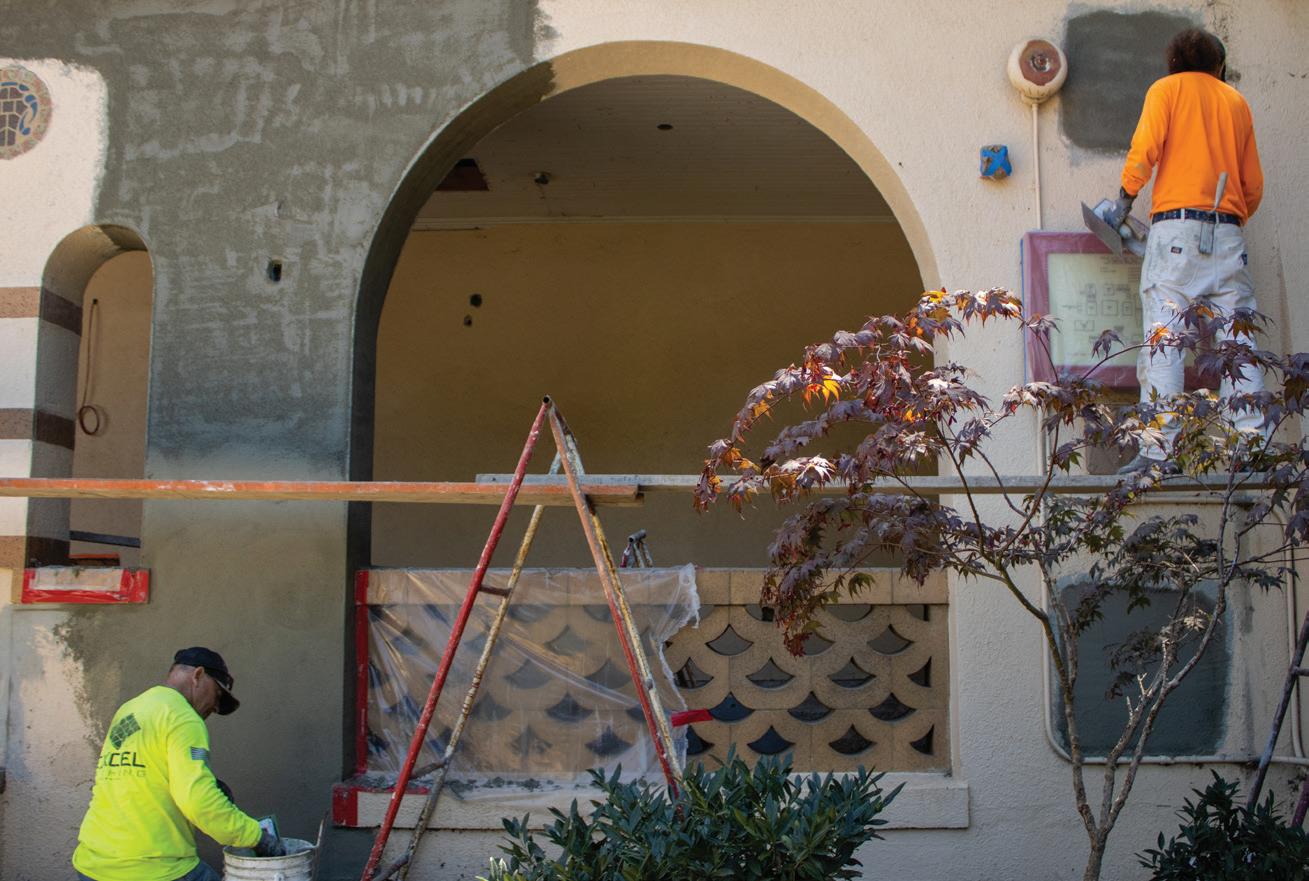
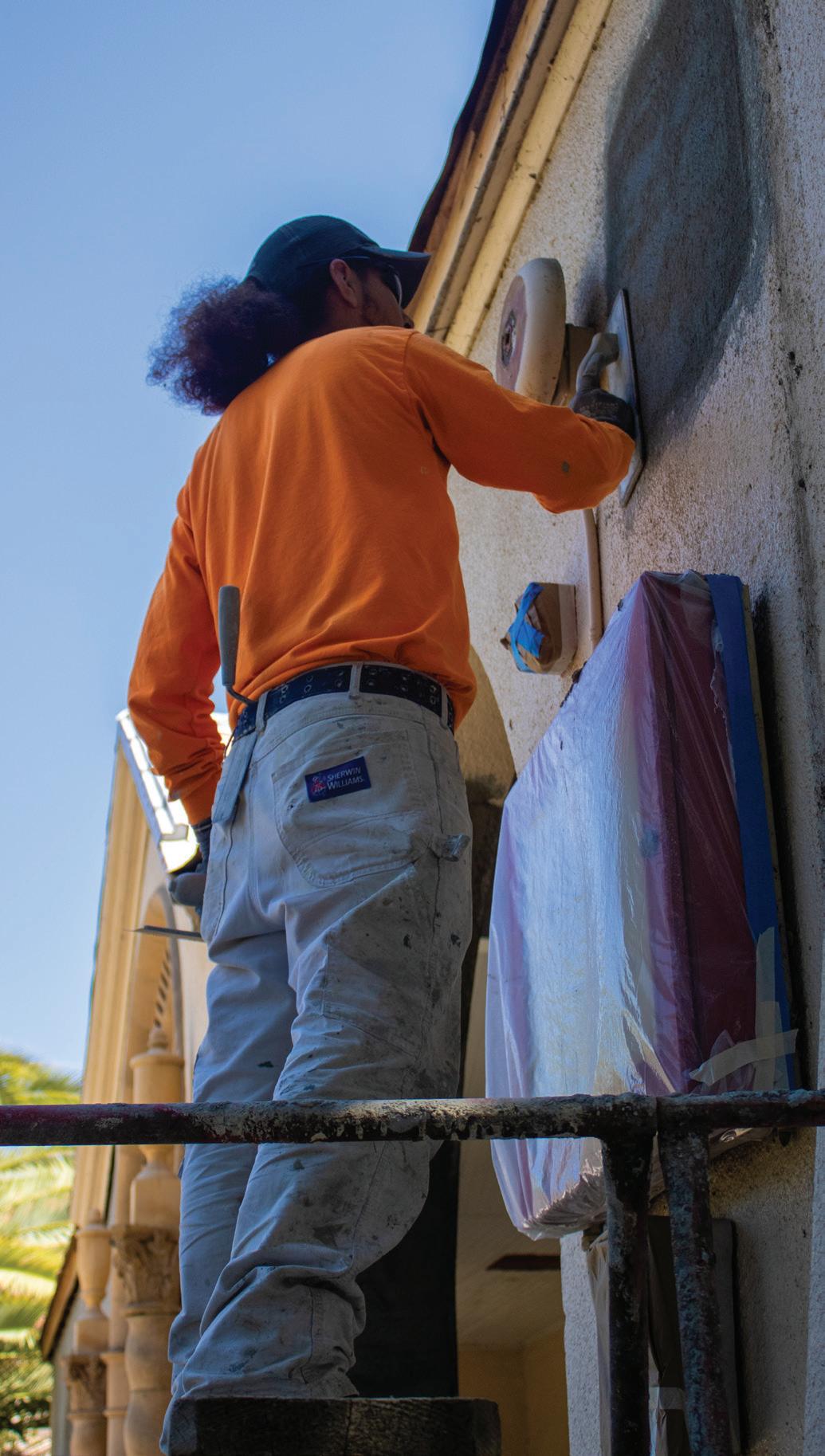
“The more challenging thing is trying to work around students, so you guys could keep going and studying,” Perez said.
According to Berkson, the students should look forward to the benefits the renovated building will bring.
“There will be a new, more welcoming entryway for when people come in and a nurse’s office that allows us to have a quarantine room,” Berkson said.
The library in the Tower Building will return to its original look and become the peer tutoring center, three or four times the size of its current room.
In addition to a new elevator, technology and patio, a new roof, windows, and stucco, new heating, ventilation and air conditioning systems will be installed, all costing $23.4 million, Berkson said.
“It’s just time,” Berkson said. “We had a building that was about 100 years old, with a 100 year old HVAC and [heating, ventilation and air conditioning] and electrical system so just the infrastructure needed to be taken care of at some point.” v
LAYING
MENDING AND SMOOTHING (right) — A construction worker stands on a ladder, smoothing out stucco on a wall on the outskirts of the Tower Building. “[In the design process], we bring in all the players, the different peope who get involved, including the architects and construction people,” Berkson said. OUT (top left) — Three construction workers carefully lay out long strips of paper by the front of the Tower Building. “Every time you have an idea [for design], the puzzle pieces have to fit,” Assistant Principal Jerry Berkson said.A STABLE STRUCTURE (top left)— A construction worker meticulously hammers a nail into the ground to establish stability. “It [the tower building] is finally now set up for current times, instead of putting a bandaid on everything every single time we have needed a fix,” Berkson said.

TOWER BUILDING HALLWAY (right)— As you look down the main hallway on the first floor in the Tower Building amid construction, you see wires, boxes and chairs populating the area. “There will be a more welcoming entryway when people come into the main office,” Berkson said. Photo: Chloe Huang
INSTALLING ELECTRICITY (bottom) — A construction worker stands below ground mending the outdated electricity system. “Setbacks happen here and there with [fixing] electrical and water [systems],” Berkson said.

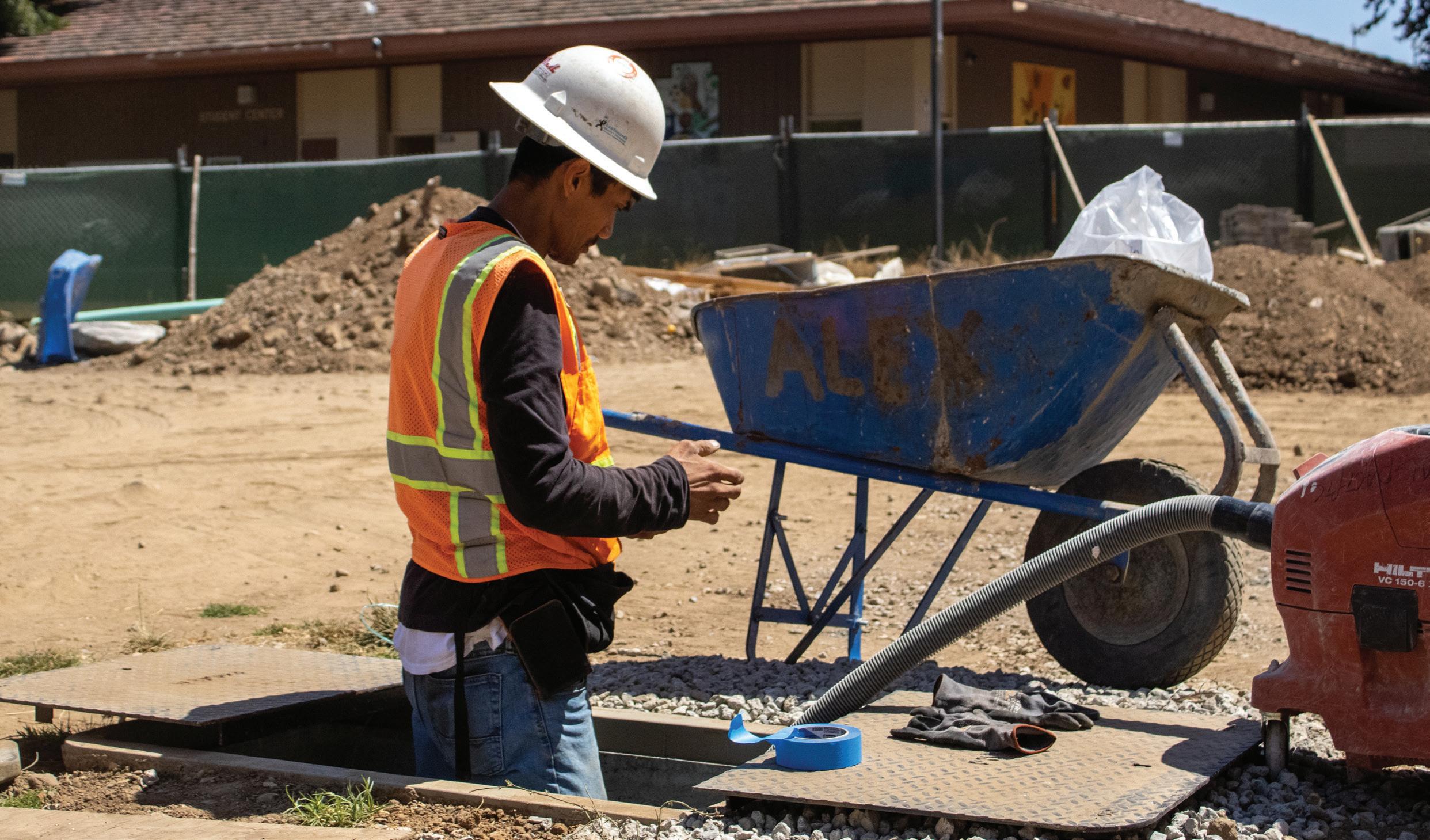
WITH AN EXPANSIVE farm stretching across 1,600 acres of the Santa Cruz foothills, Hidden Villa’s attractions include lush gardens, beautiful hiking trails and adorable animals that visitors can greet and learn about.
The local farm in Los Altos Hills is a non-profit organization centered around environmental education, social justice and community engagement.

Many Palo Alto High School students have visited the farm as or participated in summer camps and educational programs that provided hands-on experiences with nature.
Now, as Hidden Villa prepares to celebrate its centennial in 2024, the farm is at
a crossroads: a time of celebration but also of working to overcome recent controversy.
In June last year, window tiles on the Duveneck house decorated with pre-Nazi era Buddhist swastika symbols were removed, but multiple staff resignations in protest of administration’s handling of the symbols led to the closure of Hidden Villa’s summer camp programs for 2022.
Hidden Villa is now run by a different director, Elliot Wright, who is trying to lead the organization beyond the controversy by renewing efforts to increase focus on diversity and inclusion, like implementing multilingual signs across the property.
Jessica DuVal, Hidden Villa’s director of development and“Somewhere around the harvest season, [we plan on] having a farm table feast for people to come and celebrate.”
— JESSICA DUVAL, director of development and communications at Hidden VillaText by JESLYN CHEN and MAYA RAJBHANDARI PORTRAIT PERFECT — One of Hidden Villa’s sheep pokes its head through the fence and poses for a close up. “Hidden Villa was a really nice way to be with nature, there were many animals to see, ” senior Chris Owens said. Photo: Kensie Pao
communications, explains that there are celebratory events planned throughout the end of 2023 up until the end of 2024.
“One thing we’re talking about is having the summer camp staff invited from all of summer camp history to come out to the property and share their stories when they were at Hidden Villa,” DuVal said.
Hidden Villa plans on combining the celebration with their annual sheep shearing event in April 2024 and a harvest event in October 2024.
“Somewhere around the harvest season, [we plan on] having a farm table feast for people to come and celebrate,” DuVal said. “We’re working on getting a recognizable name of a keynote speaker to kick us off and a big celebration of what the place and people of Hidden Villa have done and looking towards the future.”
Given the upcoming anniversary,
Verde decided to look back at the last 100 years of this local treasure and forward to its future.
Origin of the farm
Frank and Josephine Duveneck purchased the Hidden Villa property in 1924, and opened it to the public the same year.
The Duvenecks already had a home in Palo Alto and would spend weekends and summers at Hidden Villa.
However, in 1929 the couple decided to move there permanently after realizing they enjoyed their time at the farm more than their previous home. Josephine’s autobiography “Life on Two Levels” details the mission of Hidden Villa.
“We purchased the land because we fell in love with it, and it has been our policy ever since to preserve and cherish its pristine beauty for other lovers of nature now and in future generations,” Josephine
said in her book. She explains the guilt that came with being part of the upper class at a time when most others were out of work and money due to the Great Depression.
“We were living an exclusive life, on an island as it were, with no bridge to the mainland,” Josephine said in her book. “We read about what was going on [the Great Depression]. To be merely an onlooker left me unsatisfied. But where were we to connect?”
It was also around this time that Josephine began witnessing the racism and lack of diversity in the Palo Alto and Los Altos community. She became aware that her spacious property, wealth and privilege provided her with the means to make change.
“I wondered what I could do as an individual to make an actual concrete program to combat discrimination and further integration,” she said. “What did I have at my disposal to use in such a cause?”
Duval talks more about the Duveneck’s efforts at creating positive change within their community.
“In 1945, they [the Duvenecks] started the first multicultural residential summer camp [in America] and in 1970, on the first Earth Day, they started their environmental
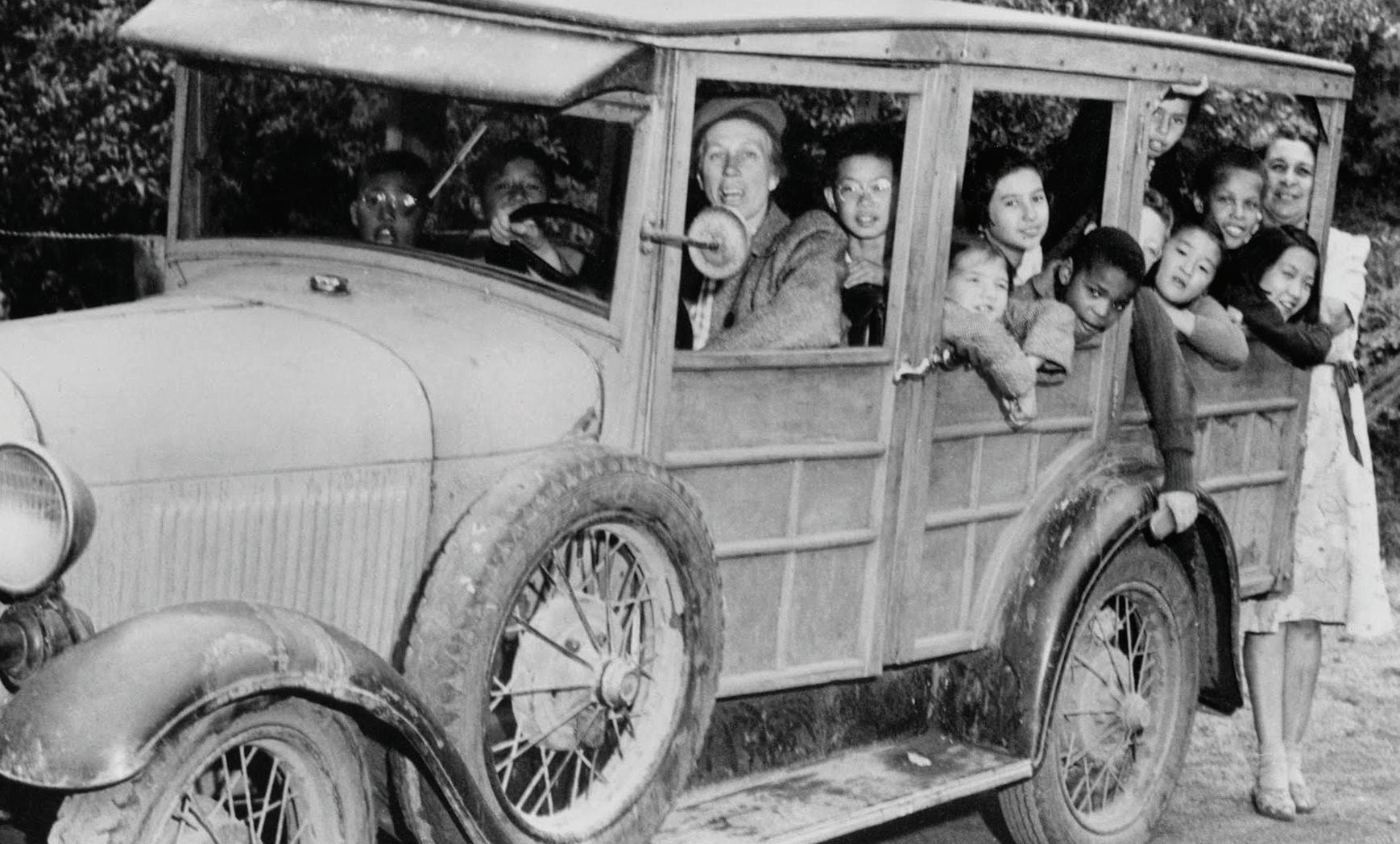
“ We read about what was going on [the Great Depression]. To be merely an onlooker left me unsatisfied. But where were we to connect?”
— JOSEPHINE DUVENECK in her book, co-founder of Hidden Villa
education programs,” DuVal said.
Elliot Wright, vice chair and president of Hidden Villa, describes Josephine’s reasoning for the summer camp.
“For Josephine, it was really important to put forward camps that were inclusive and available for anyone to participate in,” Wright said. “If they didn’t have the money, resources, knowledge or had fear-based barriers, she’d knock all of them down so that all kids can participate,” Wright said. “Why did she do it? It’s who she is.”
Hidden Villa now
Since its creation, Hidden Villa’s mission has remained the same. According to The Trust for Hidden Villa’s website, the farm’s “passion for connecting people to their food, their environment and to issues of social justice is woven through everything we do.”
The Trust for Hidden Villa was established in 1960 by Frank and Josephine. When they passed away, their children donated their land to keep the trust alive.
David Duveneck, grandson of the founders Frank and Josephine Duveneck and a member of the Hidden Villa board of trustees since 2008, explained how Hidden Villa became a nonprofit organization.
“My grandparents went to them [their children] and said ‘What do you want to do with Hidden Villa? We [Josephine and Frank] would like to turn it into a nonprofit ... but it’s your call,’” Duveneck said.
The trust continues Josephine’s original mission by funding Hidden Villa’s summer camps, environmental education program and donations of the farm’s organic produce to the local food banks.
“We [Hidden Villa] have partnerships with Community Services Agency Mountain View, a health human services education and food pantry,” Wright said. “We get thousands and thousands of pounds of food out each year to them and we have about 800 families that we serve through CSA.”
Over the last century, Hidden Villa’s efforts at preserving Josephine and Frank’s original purpose have made an impact on the Palo Alto community. The farm’s board
JOYRIDE (LEFT) — Campers at Josephine Duveneck’s multiracial camp ride in a car with their counselors. “For Josephine, it was really imporstant to put forward camps that were inclusive for anyone to participate in to make sure that barriers to access were addressed and that if they didn’t have the money or resources or knowledge or had fear-based barriers that she’d knock all of them down so that all kids can participate. Why did she do it? It’s who she is,” said Elliot Wright , vice president and chair of Hidden Villa. Photo courtesy of Hidden Villa
SAY CHEESE (TOP RIGHT) — Counselors of Hidden Villa’s multiracial summer camps pose for a group photo. “She [Duveneck] believed strongly in equal access to opportunities and helped create one of the first multicultural youth camps in America,” Wright said. Photo courtesy of Hidden Villa


COZYING UP (BOTTOM RIGHT) — Campers snuggle up with blankets and pillows during one of Josephine’s camp storytimes. “Had you ventured in around one or two o’clock of a summer afternoon you would have been amazed to see the room transformed into a veritable flophouse. At this hour I would’ve been sitting in an armchair, reading aloud such things as The Jungle Book, Kontiki, Black Beauty, A Tale of Two Cities or other delightful books,” Josephine Duveneck wrote in her book, Life on Two Levels. Photo courtesy of Hidden Villa
of directors view the 100 year anniversary as a time to reflect on its original mission.
“I hope that every day we truly are living their vision of that place and I think we’re doing a really good job,” DuVal said. “The one [question] that we’re really asking ourselves is: what can we be doing more of? How can we continue to serve our mission in a way that is relevant to what’s happening around us today?”
Duval’s reflections of Hidden Villa’s current involvement in the Palo Alto and Los Altos’s community align with Wright’s ideas about Josephine’s similar goals surrounding community support.
“She [Josephine] played a role in almost every forward leaning effort,” Wright said. “I think she would be really proud of the efforts we have to serve resilient, underrepresented communities in the Bay region.” v
“
I think she [Duveneck] would be really proud of the efforts we have made to serve resilient, underrepresented communities in the Bay region.”
— ELLIOT WRIGHT, vice president and chair of Hidden Villa
SEVENTY SIX PERCENT OF surveyed professional reporting journalists in the United States are white, according to the Pew Research Center.
When Palo Alto High School senior Grace Gormley set out to identify an issue in a field of her choosing for her Girl Scout Gold Award project, she came across this alarming statistic.
“I love Paly journalism,” Gormley said. “A problem with it is that it doesn’t represent the greater Paly community, and that’s also a problem with journalism in general. So I figured, ‘how can I address the root cause of this?’”
Gormley received a Media Arts Center innovation grant to fund the camp, a cash fund dedicated to supporting student projects, which was used to to cover the costs of printing the magazine.
“The MAC innovation grant was a big part of the reason that I was able to print physical magazines for all the kids to have,” Gormley said. “That was a super important part of the project for me.”
Gormley ran the program through
DreamCatchers, an organization that aims to close the opportunity gap in Palo Alto’s middle schools by providing after-school enrichment, tutoring and summer programs to low-income students. According to Palo Alto Unified School District, an ever-present achievement gap shows a noticeable separation between the academic achievement of white and Asian students versus Black and Latino ones, with a specific disadvantage for students from low-income families.
“I was hoping for maybe 20 kids,” Gormley said. “But then DreamCatchers liked the curriculum that I had written and they adopted it as part of their summer program. It expanded from there, because instead of teaching maybe 20 kids, I ended up teaching about 75.”
Gormley worked with DreamCatchers to design curriculum for children in sixth through ninth grades. The 10-day class was spread over four weeks during the summer.
“A lot of it was based off of my own experiences in Beginning Journalism, off of certain things that I liked learning about,” Gormley said. “And then some of that came from my own process of thinking of story ideas and writing stories.”
Part of DreamCatchers’ mission is to provide opportunities for older students and community members to share their knowledge and experiences through their own, self-designed curricula. Students work with a varying amount of supervision to create their programs.
“We very much source [curricula] from within our community so that students are building a larger community around them and having different people provide this learning,” DreamCatchers Executive Director Nicole Chiu-Wang said. “It’s really up to them [the students who propose the projects] to design. If they have something and they want input, we’re happy to provide that. We’ve been really blessed to have students come with really fully-fleshed out, very professional ideas for programs and content that they want to provide to our [middle school] students.”
Gormley hopes that in future summers, her curriculum will continue to benefit kids in need all over the country.
“I created a website with all the resources I used,” Gormley said. “[The website has] all the tips and tricks and the curriculum and all the slides, so that I could share it with teachers from around the country and try and expand it that way.”
Even after her time at Paly is over, Gormley hopes that future students and teachers, as well as the DreamCatchers organization, will continue the project.
“I am hoping to make sure that it can be repeated with DreamCatchers every year,” Gormley said. “I want to be there next summer to help with that transition, but I hope that it can become its own free-
“ We very much source [curricula] from within our community so that students are building a larger community around them and having different people provide this learning.”
— NICOLE CHIU-WANG, DreamCatchers executive director
A lot of them were afraid to present theirs at the end, so it was really nice giving them that little push they needed to get through it and seeing how excited they were.”
— ANNE THRELKELD, counselor
t
“
standing project without my intervention.”
Paly senior Anne Threlkeld, one of the counselors involved, said that she found the experience educational for herself as well, despite not being a journalism student herself.

“I learned some new things myself,” Threlkeld said. “Because it [the camp] is at a middle school level, it mostly used similar writing techniques to what I’ve learned [in
“I’m really glad that we were able to share journalism with these kids, especially because a lot of them are underprivileged,” Lee said. “Being able to expose them to Paly journalism early on … I think that’s a great thing, and I really hope all of them pursue journalism.”
While the purpose of the camp was in part to teach students about journalism, Gormley thinks that the sense of pride and
— A participant looks closely at the finished magazine. Counselor Holden Lee enjoyed watching students face their fears of sharing their work. “Some of them were pretty nervous, but everyone got through it,” Lee said. “Everyone had a smile on their face at the end.”
Photo by GRACE GORMLEY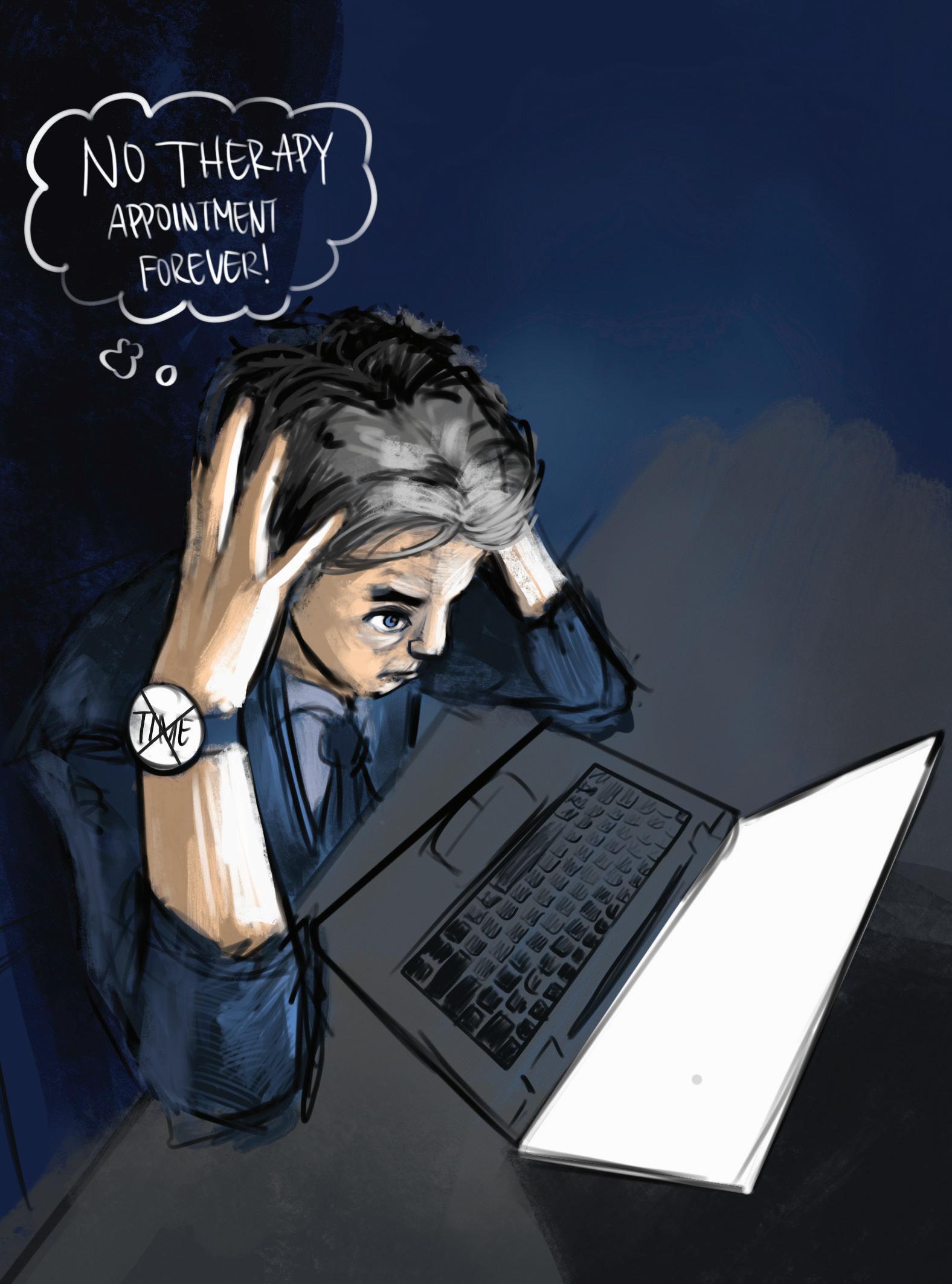
IWAS SCREAMING AT THE screen.”
That’s what Superintendent Don Austin said of his experience trying to access mental health services through the district’s systems.
“I started to notice it [mental health struggles in] March, and didn’t reach out until May, which I think is probably super common,” Austin said. “I could feel it getting progressively worse. But I just kept thinking I could get through it, tomorrow will be better. And tomorrow wasn’t better. … [In] April, [it] started to get more significant, to where I really started to have to fake my way around this office. And then May was just torture. It was horrible.”
Austin said that he felt alone in his experience before he was able to get help.
“I think when you’re in the middle of … essentially a crisis when it comes to your mental health, you think you’re the only person to have ever had that problem,” he said. “You don’t think straight and you feel alone, even if you’ve got people around you. … It was a really terrible time. But once I started to get the help I needed and I started getting my feet back under me, I became less embarrassed about it.”
Austin said that he struggled to access care quickly and easily. “My struggle was it took me 18 [calls], it was [after] 19 [calls] where I finally got to talk to somebody,” he said. “That’s ridiculous. Final-
ly I got to somebody on No. 19. It was through my primary health care provider. Now that’s more for long-term care. And once I got there, and it took weeks to get there, and every day was worse than the day before as this is going. She [a therapist] pretty quickly got me feeling like okay, there’s hope.”
Austin first shared his story publicly at an annual Palo Alto Unified School District kickoff event in August. The event, known as the Chowdown, took place at Henry M. Gunn High School. Weeks later, in an interview with Verde, Austin shared further details about his mental health story, his choice to share it and the new resources available for staff and teachers.
As a result of his experience, Austin led an overhaul of the district’s mental health services for teachers and staff. This included hiring Lisa Romero, an inhouse specialist who can be seen on demand and redesigning the website where teachers and staff access resources. Austin said that the district has been getting positive feedback about the new system.
“The feedback we’re getting right now is amazing, that you can literally pick up the phone or go on your computer and be seen,” he said. “It’s seamless. It’s confidential. It’s fast. That wasn’t true. So for that, I feel really good.”
According to Austin, Romero will also be helping staff and teachers get connected to longer term care.
“I would frame this as the equivalent of like a tier three support [system], when you’re actually seeing a therapist, either short or long term,” he said. “Lisa Romero’s gonna be great for this, for the people that need to see someone a few times and work through something. But I think [what’s] just as important is that she’s also going to help people navigate the system to get to long term health care.”
Austin said that “a lot of reflection” led him to share his story at the event.
“I really experienced something that was new to me and probably not new to other people,” Austin said. “If you have a perception that a 52-year-old, 6-foot-4, ex-athlete superintendent always has everything together and is always in control because he’s got a deep voice and can wear a suit, you’re missing it.”
Austin said that he felt an obligation to share his story as a leader.
“If I’m in a leadership position, and I am, I can’t be the person that says, ‘You guys might be struggling. And because I’ve got my stuff all together, I’m going to do these things for you,’” Austin said. “Then I’m that guy that has to portray [himself] like I’m something invincible. And I’m not. So I thought it was important to share and be the person that stands up there and says, ‘You might be feeling like this. And so did I.’”
PAUSD’s Director of mental health & wellness, Dawn Yoshinaga, said that Austin’s choice to share his story had a large impact on on the district’s mental health program.
“That speech that Dr. Austin gave really … changed a lot of things overnight for a lot of us,” Yoshinaga said.
“
It took me 18 [calls]... it was [after] 19 calls where I finally got to talk to somebody.”
— DON AUSTIN, Superintendent
ability].’ And so it would be this long process.”
Since then, the district has led an overhaul of the system for teachers and staff to access mental health resources. The changes were led by Austin after experiencing firsthand difficulty navigating the district’s system. Austin first shared his story with teachers and staff at a Palo Alto Unified School District kickoff event in August. Brimhall, who attended the event, said she appreciated Austin’s speech.
“I thought he [Austin] was brave to talk about his own story,” Brimhall said. “I think it’s a good thing to revamp the systems that are in place, because the old systems were really hard to navigate.”
Brimhall said she thinks sharing personal stories about mental health can help others feel comfortable sharing theirs as well.
“I think the more we can, across the board, be authentic about our own mental health struggles, it helps everyone in the community feel okay about bringing forth their own struggles, which is all for the good,” Brimhall said. v
FROM PAGE 23


“I think just having that vulnerability out there and sharing that piece where everybody could connect … I think that normalization and destigmatization that he’s talking about is a real thing. ”
Yoshinaga said that Austin’s decision to share his story has helped bring attention to the district’s new resources and facilitate conversations surrounding mental health.
“I’ve been talking to principals and they’re having conversations with people about their sessions … not necessarily Lisa Romero but maybe their own private therapy,” she said. “I feel like that has really helped us grow the program.”
Austin said that the previous website setup made resources difficult to access.
“ Why are you going to a mental health website? You’re probably not looking because you’re feeling awesome that day,” Austin said. “The last thing you want to do is feel stupid about not being able to find something on a website. And I was. I was screaming at the screen. And then I got to think[ing], I’m actually in charge of this. I’m essentially screaming at myself right now.”
Austin said that the district will now excel in teacher mental health services.
“Did we do a good enough job for staff mental health in the past? No,” he said. “Straight up. No. Where are we now? … We’re at, or above the standard of the state. Now we’re gonna lead the state.” v
ICAN’T TAKE the constant lies and attacks,” Superintendent Don Austin wrote. The day was May 18, and Austin was in the midst of two related challenges. The first was a tussle with a school board member over her former campaign manager’s online postings. The second was coming to terms with and seeking help for the mental health crisis he was experiencing.
An Aug. 30 article published in the Palo Alto Daily Post exposed text messages from May between Austin and school board member Shana Segal.

In most cases, Verde would not publish a conversation that seems so private in nature. However, given Austin’s status as a public figure, Verde has decided the matter is sufficiently in the public interest.
The text exchange began May 18, when Austin sent a series of messages to Segal addressing online criticsm of him from Segal’s former campaign manager, Gayle McDowell. In the messages, Austin urges Segal to make her stance on him known.
“Seriously, just own it and it will be easier,” he said. “I am ready to go out soon. I can’t take the constant lies and attacks. You guys can pick the next person ... I’m done.”
Austin urged Segal to publicize her stance on him at the next board meeting, saying “I will have an army watching.” Austin told her that counselors, school administrators, family members and neighbors of his were “all lined up” for the upcoming meeting.
In talking with Verde, Austin declined to specifically address the text messages published in the Post. However, when asked if there was any other behavior from this time period that he regrets, Austin said he “can’t regret it.”
“Was I snappy with some people?” Austin said. “Yeah, for sure. But I’m going to give myself permission to not regret it. Because if you regret it, that means that you were totally in control of it. And I wasn’t. So were there things where I was acting differently than I would today? For sure ... I think if I had a regret it would be not being strong enough to get help earlier. I regret that … But the other stuff? No, there’s no regrets there.”
As a result of his experience, Austin led an over-

haul of the district’s mental health resources for teachers and staff. These changes have included hiring an in-house staff mental health specialist that teachers and staff can call for support. Austin said that he has received messages from PAUSD teachers thanking him for these recent changes.
“Another teacher I really respect wrote me and said ‘Thanks man,’ and she made her appointment [with the PAUSD in-house staff mental health specialist] that day,” he said. “But [she] also said ‘It’s really brave [to share the story] because some people are gonna use it against you.’ And they have. Some people suck.”
Austin said that sharing his story has garnered criticisms online.
“There [were] people even yesterday posting pretty mean things, saying that I’m whining about things and criticism and having ‘wah wah wah’ after it and just further attacking,” he said. “Now, they don’t get a space in my head ... At the end of the day, a good friend of mine said, ‘Well, it’s hard. You get to be you and they have to be them.’ And that’s just how I have to resign myself and so some people take pleasure out of hurting other people. I’m not one of them, but I’m very aware that they exist.” v
 Text by CHLOE HUANG and AUGUSTUS SOEDARMONO
Photos by KENSIE PAO, Art by TALIA BONEH
Text by CHLOE HUANG and AUGUSTUS SOEDARMONO
Photos by KENSIE PAO, Art by TALIA BONEH
AS YOU STEP INTO Mike’s Diner Bar, laughter and banter from multi-generational families fill the space, creating a warm ambiance and a sense of community. Old and new customers enjoy the popular dishes, Mom’s spaghetti and the classic hamburger.
However, just a few months ago, the fate of this community restaurant was uncertain. From July to September, this diner grappled with an eviction case. Having garnered a fantastic reputation in the community in the 29 years of business, loy

ever, that night, he was in the El Camino Hospital emergency room tending to his daughter, which led him to be a day late on his $22,000 rent for the month of July.
The next day, he received a letter from Ventana Property Services informing him of his eviction: he would need to be out by 7 a.m. Sept. 11 due to the late rent.
“I hired a lawyer and with the emotional toll it takes on you, there’s not much I could do,” Wallau said. “I tried to resign myself to the fact that I could be done here after 29 years.”
It took a large
However, the eviction case is not the only problem that Mike’s has faced before.
Wallau did not always have this supportive and loyal community of customers. His journey of building up a restaurant from scratch was full of obstacles from the beginning.
Before he opened the Diner Bar, Wallau said he worked as a waiter at a family friend’s French restaurant and was forced to learn to maintain a healthy and loving relationship with his family while working 9-10 hours, as there were times where he couldn’t be home for dinner.
— The owner of Mike’s Diner Bar, Mike Wallau, sits at a newly refurbished table, pondering what he can do in his situation. “This is a difficult business, you work seven days a week for sometimes [in my case] for 25 years,” Wallau said, “Having this extra stuff to worry about is not desirable.”
“ I was trying to resign myself to the fact that I might be done here after 29 years.”
— MIKE WALLAU, owner
Wallau educated himself about diabetes and gave his all to be there for his daughter.
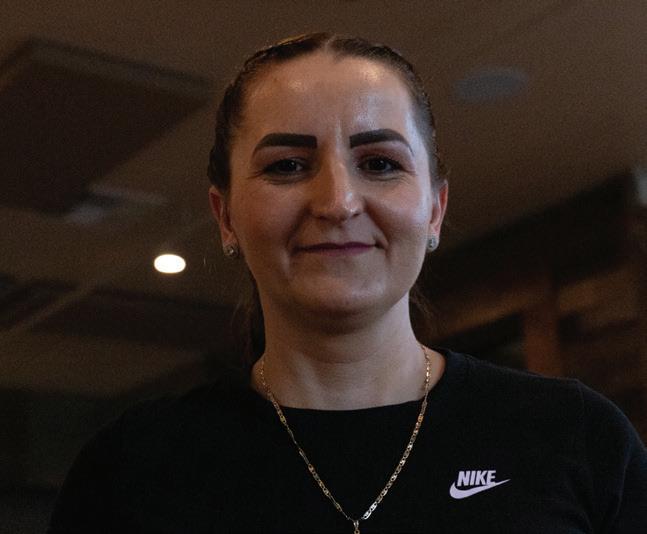
According to Wallau, not only did family and friends support him in his journey, but the property owners showed compassion towards him in the beginning.
Two family-owned companies had owned the property since the beginning of the lease, Scher Holdings LLC and Finebaum.
“They loved me,” Wallau said. “I rebuilt this whole building.”
Nonetheless, according to Wallau, many years later, as the pandemic hit and personal struggles were added to his plate, he noticed the owners’ attitudes shifting. Both owners had passed down their company to the next generations which had become irritable and uncooperative with him due to family disputes regarding company share percentages, Wallau said.
“They just seem[ed] to want to get more and more money out of me [to] then be kind of unreasonable,” Wallau said. “I spent $2 million on [renovating] their building, [so] I would think that they would be a little more grateful.”
In the past 29 years, Wallau has said that he has paid his rent late only a couple of times and was asked by the owners of the older generation to sign a waiver agreeing to his rent not being late again.
“I actually was one day late [after signing the contract], but they let me pay with no [late] fee,” Wallau said.

Wallau said he is immensely appreciative of the loyal community of customers that supported him in avoiding eviction and

that he could not have come this far without the constant flow of love and appreciation.
“We’ve had an incredible amount of support from Mayor Lydia Kou, to the city manager and the vice mayor,” Wallau said. “Everybody has tried to help with this situation.”
Len Filppu, long-term customer and head of the Fairmeadow Neighborhood Association, has always enjoyed eating and socializing at Mike’s Diner Bar and is among the most active supporters of the restaurant.
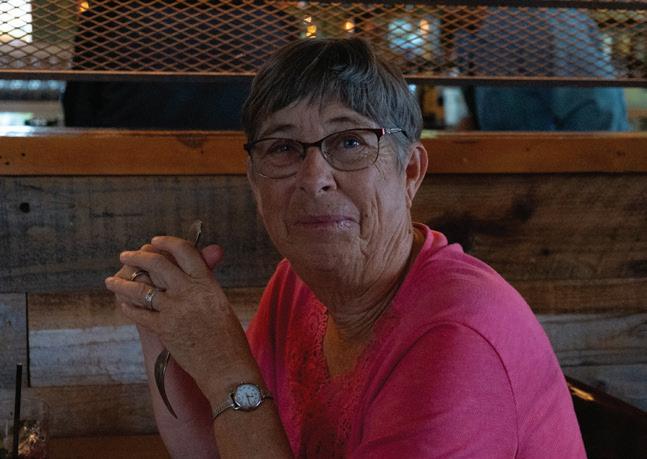

“There’s a community atmosphere here; neighbors can walk or bike to Mike’s,” said Filppu, who is married to Palo Alto High School English teacher Lucy Filppu.
“We can meet each other, talk [and] share experiences. It’s a neighborhood-serving facility that is very important in this age of mostly corporate businesses.”
Many long-time customers like Paly alumnus Rick Farmer, class of ‘73, said they believe that Wallau has cultivated a community center that provides opportunities to help many young generations to grow and build connections.
According to Farmer, he, along with many other customers, enjoy supporting a local restaurant run by a local person.
“Mike also hired a lot of my friends’ kids,” Farmer said.
“A lot of kids who grew up [in the Midtown neighborhood] work here.”
From establishing a successful restaurant to motivating himself to learning to deal with family issues on the side, Wallau said the key to running a great restaurant is to do his best with what he is in control of.
“I just take it one day at a time and do the best I can,” Wallau said. v
“I made friends with all the coworkers and all the customers have become my second family.”
— MILA MOORHEAD, waitress
“He [Wallau] has put $2 million of his own money into this remodel. This is a beautiful, brand new and wonderful facility restaurant.”
— LEN FILPPU, head of Fairmeadow Neighborhood Association
“It [Mike’s Diner Bar] is right around the corner and we like that Mike’s is local. It’s a nice atmosphere and I like how the people from the neighborhood like coming here.”
— ANNETTE ISAACSON, customer
“ It’s a neighborhood serving facility that is very important in this age of mostly corporate businesses.”— LEN FILPPU, head of Fairmeadow Neighborhood Association
EACH FALL, GENERATIONS
of local residents and Stanford University alumni cheer for the Cardinals football team, excited to see their team face the tough competition of the Pacific-12 Conference.
“Stanford football has become a gathering place on ‘ball Saturdays’ for friends,” said Ryan Craig, a Palo Alto resident and Stanford alumnus. “It’s a real ritual that involves the whole family.”
The Pacific-12 Conference (Pac12) is a college sports league of 12 teams from six different states in the western United States. Since 1959, the Pac-12 has organized fierce matchups that devel

However, things changed dramatically on Aug. 4 — the day that five of the teams announced plans to depart the league. All but two Pac-12 teams have since left; Washington State and Oregon State remain.
The Pac-12 is one of the Power Five conferences, along with the Atlantic Coast Conference, the Big 10, the Big 12 and
Power Five are the strongest and highest-earning college sports leagues in the United States, but among the Power Five, the Pac-12 pays the second-least per school, only ahead of the Big 12.
The Power Five conferences combined earned $3.3 billion in revenue in 2022, according to USA Today, making college football a huge business for broadcasters such as ESPN and
In 2022, the University of Southern California and the University of California, Los Angeles, announced they would join the Big Ten conference for the 2024 season, becoming the first teams to leave the Pac-12. In the following months, all but four of the remaining Pac-12 teams
left for other conferences.
A likely factor in their departure was that leaving the Pac-12 became more financially lucrative than staying. The Big Ten leads the Power Five conferences in earnings with $845.6 million in annual revenue, according to CBS Sports. Power Five schools also have the highest individual payouts at an average of $58.8 million, while the Pac-12 had the lowest at $37 million. With only four teams remaining, Stanford and Cal announced in September that they will join the Atlantic Coast Conference for the 2024 season, leaving only Oregon State and Washington State in the Pac12.
Stanford and Cal will now travel to more east coast schools and compete with universities they have never played before. They will be more exposed nationally, and can bring new deals and money to their athletic programs.
According to an announcement made by Stanford Athletics, the revenue from long-term media deals and conference affiliations will give key financial support to Stanford athletics in the coming years.
The collapse of the Pac-12 conference left Pac-12 players reflecting on their decision to join the conference.
Amelia Vugrincic, a member of Cal women’s beach volleyball team and Palo Alto High School alum, said that the name of the Pac-12 impacted her decision to play at Cal.
“Growing up, I really wanted to play at a Pac-12 school, and the Pac-12 brand meant a lot to me,” Vugrincic said. “It is
“ It seemed ridiculous for Stanford and Cal to go to the Atlantic Coast Conference, but I understand why it’s probably the best option they [Stanford and Cal] had.”
— RYAN CRAIG, Stanford University alumnus

kind of sad to see something that was so iconic to me no longer exist.”
The move to the ACC will have a different effect on each sports program, since each sport has different gear, travel or facility time requirements and needs.
However, as a beach volleyball player, Vugricic says the loss of funding and resources from moving to the ACC won’t be much of an issue for her.
“We’re not super expensive because we don’t have a lot of gear and our roster is pretty small compared to some other sports,” Vugricic said.
Additionally, the ACC does not host beach volleyball and so the team will likely be unaffected by the geographic reach of the ACC, unlike sports such as soccer.
Lizzie Boamah, a Stanford women’s soccer commit from San Diego who will play in the 2024 season, said she will miss playing against west coast teams as a Californian.
“It’s just going to take away the homey aspects of playing in the Pac-12,” Boamah said. “Being on the West Coast, my parents aren’t going to be able to go to as many games, which will be a little sad for me.”
Along with having less time in California, athletes will have to travel as far as Boston to play a conference game.
“I feel like the amount of stress that it takes on your body to have to fly for like five hours and then play a game is obviously going to be different,” Boamah said.
Other future Stanford commits are excited to face the new competition of the ACC.
“I’m excited, honestly, I think it’s gonna be a really fun experience getting
to play in the ACC,” said Charlie Bates, a Paly senior who is joining the Cardinal’s baseball team in the 2024 season. “There’s been great competition in the [ACC], and I’m excited to be a part of it.”
According to an announcement made by Stanford Athletics, Stanford is trying to make traveling easy for student athletes.
Twenty-two of Stanford’s 36 sports will see minimal or no scheduling impacts.
The ACC is also working to have many games scheduled during the weekend to minimize the impact of travel for student athletes.
In joining the ACC, there is an entirely new roster of competition, including Duke University, Wake Forest University, University of North Carolina and Boston College, all of which are east coast schools.
According to Boamah, the move to the ACC allows Stanford to play the best teams in the nation such as University of Carolina, which is ranked first for Division One NCAA women’s soccer.
“I definitely think ACC has one of the best schedules in the country, at least for women’s soccer,” she said.
Loyal Stanford fans like Craig said that the decision of Stanford going to the ACC was tough to face.
“When the ACC became the only spot [Stanford] was going to land, it was depression and anger,” Craig said.
“I understand why it’s probably the best option we had, but I am a little sad about it. And slowly, I think I’ll get to the last stage of grief, which is acceptance, where it just kind of is what it is and I’ve moved on.” v

In 2022, The Pac-12 Generated
$581 MILLION IN REVENuE
Source: CbS sports
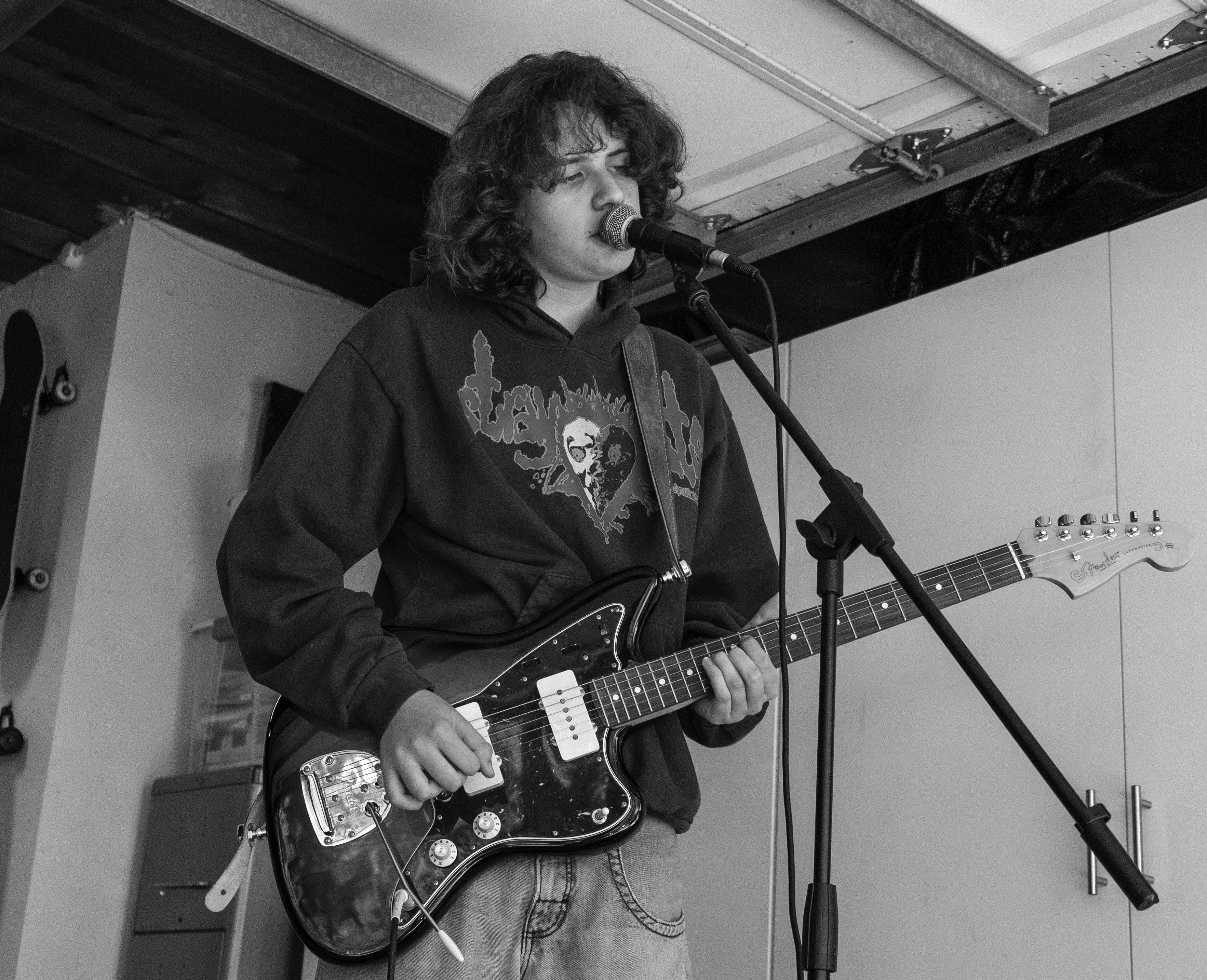

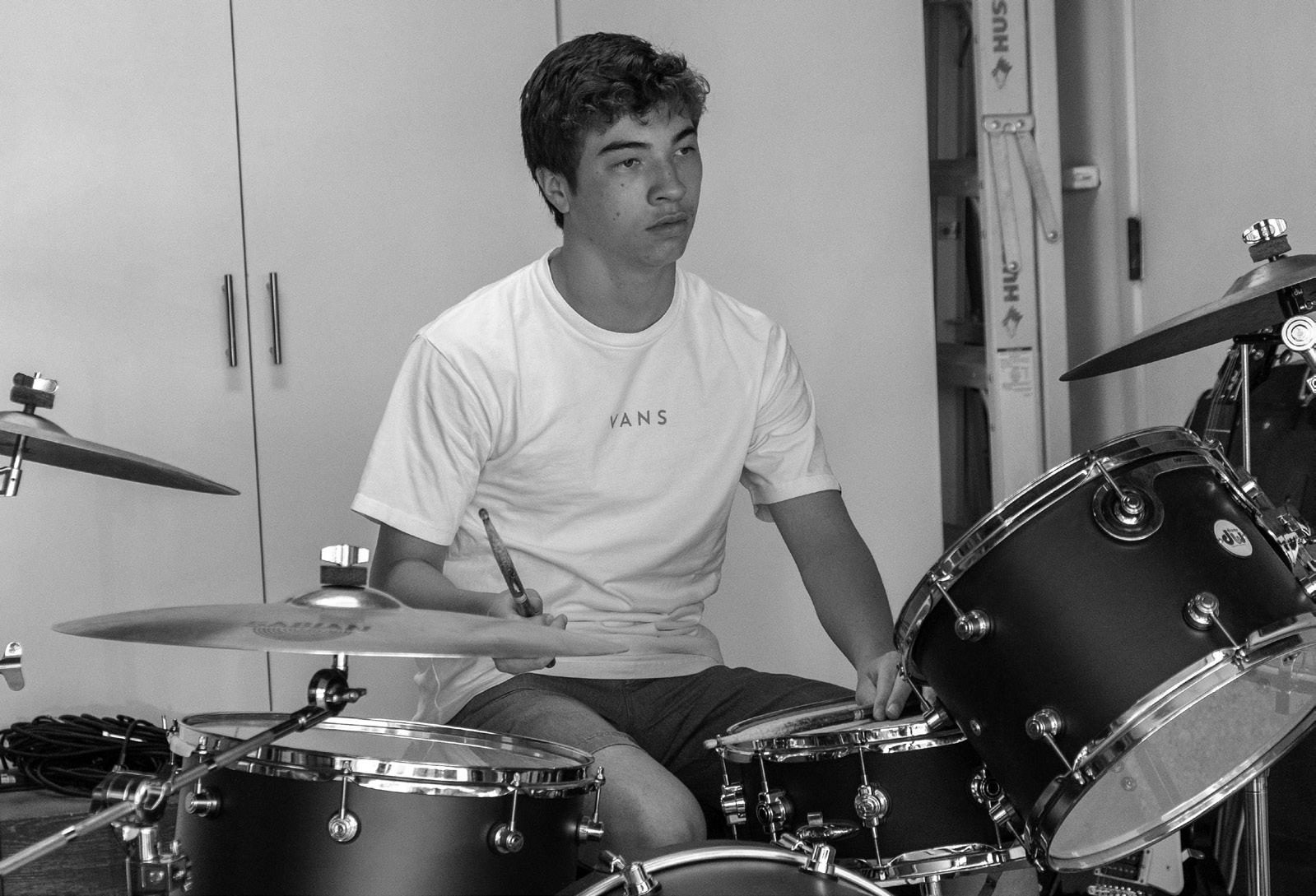 Text by DIVYA GANDHI
Text by DIVYA GANDHI
STRONG DRUMBEATS follow electric guitar twangs, creating a catchy beat. Light vocalizing complements the harmonies in the background. Two minutes and seven seconds later, “Man,” the lead song on the “Strother Field” extended play album comes to a close with a strong guitar riff that fades into distorted noises.
Strother Field, who released their first album, “Strother Field,” on Aug. 8, is comprised of Palo Alto High School senior and guitarist Max Rabbitt-Tomita and juniors Clay Cudahy, the lead singer and guitarist, drummer Dexter Cleveringa and their brand-new bassist, sophomore Casey St. Clair.
Cleveringa said the band met when he sat next to Cudahy in a seventh grade Frank S. Greene Middle School history class. While playing ‘two truths and a lie’ as a self-introduction activity, they discovered an unexpected shared interest.
“We both said we played drums, which we both assumed was a lie in the game, but it turned out that it was actually something we shared in common,” Cleveringa said.
They became fast friends and decided to form a band. According to Cudahy, the name choice was random.
“One day I just zoomed into the Midwest on Google Maps looking for interesting names of places and I thought
Strother Field sounded cool,” Cudahy said.
Cudahy and Cleveringa are the original members of the band, taking inspiration from ‘80s and ‘90s alternative rock bands such as “My Bloody Valentine,” “The Pixies” and “Pavement.”
After rehearsing and editing their lyrics and rhythms for over a year, they were ready to record their debut album.
“We ended up going in June, to a studio called Tiny Telephone in Oakland,” Rabbitt-Tomita said. “We spent three days there recording and mixing all the tracks with those four songs.”
According to Rabbitt-Tomita, Cudahy was responsible for mixing the songs and adding in edits.
“Since we only [had] three days [in the studio], we did all the mixing on the third day which, for four songs, is kind of a lot,” Cudahy said. “At home [after the recording studio], I just like to add some vocal parts and stuff.”
Cudahy said the band plans to return to live shows now that their EP is out.
“Now that we have the EP out … more of our focus is going to be playing [for] more live shows,” Cudahy said.
Other than planning to perform in live shows, the band has been practicing some new songs for future releases.
“We definitely plan on making a
full-length album within the next year before Max graduates,” Cudahy said.
“We've been working on new songs and I think we will probably start recording next summer. After that the rest of us have another year before we graduate so hopefully we’ll continue to work on new music through that time as well.”
Being a part of the band has had a significant yet different impact on all the members. For Cudahy, the band provides motivation to continue practicing music.
“I struggle sometimes with being productive enough to record or perform by myself, so having other people to play with motivates me … letting me play the music I like in a live setting,” Cudahy said.
According to Rabbitt-Tomita, the communal aspect of the band has been especially rewarding.
“It’s just really enjoyable to do and way more fun than playing music on your own … I would also just say it’s a good outlet for frustrations,” Rabbitt-Tomita said.
Cleveringa explains the importance of the band and its significance to him.
“Putting our own music out is something that we’ve all wanted to do and actually going through with that was a big deal for us,” Cleveringa said. “I consider the band one of the most important things I do and I look forward to continuing to play and release music.” v
“Putting our own music out is something that we’ve all wanted to do and actually going through with that was a big deal for us."
— DEXTER CLEVERINGA, drummer

RASHING WAVES SPILL out of the pool as players swim aggressively, grappling for the coveted ball. It is a typical water polo match, with most parents in the stands, except for a woman crouched down on the pool deck squinting through her camera lens. At any Palo Alto High School sporting event, it is likely that
ting up the schedule with fellow photographer Karen Hickey.
However, this will be her last year as one of Paly’s sports photographers. Bates’ son is graduating and she plans to pass the torch to aspiring student photographers.
“It was always my goal when I started this to encourage kids to take this over,” Bates said. “I’m not going to do this after my kid has gone, [and] I love seeing other kids on the sidelines shooting.”
are always evolving,” Bates said. “[I’ll] take a look at the new circumstance[s] and see how I can contribute to that. So I’ll probably drag my cameras…across the street [to] Stanford.”

In addition to her dedication to preserving moments of Paly spirit and athleticism, Bates has been a mentor to Paly students while uplifting athletes in her photography.
“She definitely helped inspire me,” student photographer and varsity basketball player Tyler Wong said. “As an athlete it was really cool seeing all these photos of myself and my teammates.”
teams. Bates’ Instagram account (@sko_ vikes) displays an impressive portfolio of team portraits and jaw-dropping mo-
“My mother and my grandfather were photographers … so I grew up around cameras and lenses,” Bates said.

Although she initially rejected the idea of being a photographer, Bates decided to pick up photography as a hobby after her kids were born, dabbling in por-
“When my kids got older, both of them were athletes,” Bates said. “I started photographing them and other parents and kids would say, ‘Hey, I like that. Can
Bates has branched out from baseball in the last three years to photograph events for almost every Paly sport, split-
For the past two summers, Bates has given informative presentations at Paly journalism’s Camp MAC to inspire kids to pick up photography.
She has also worked with a number of Paly students to help with their own journeys in sports photography and videography.
“I have a vivid memory of her [Bates] telling me to always try new things, even if I wasn’t sure [how] it was gonna turn out,” student videographer Clare Antonow said. “She was really supportive about going out of your comfort zone.”
As Bates closes the chapter on her time at Paly, the next stop on her photography journey awaits. With her son committed to playing baseball at Stanford University, Bates said she hopes to join the ranks of the distinguished photographers there.
“I think the most interesting people
Bates said she believes there is a value in the comforting nostalgia of photos. This is evident through the various students she has impacted.
“There’s that adage that a photo or picture is worth a thousand words,” Bates said. “When you see how sports or an image … can elevate the enthusiasm and the sense of belonging to community … we can create an element of pride in being a part of something bigger than yourself. I think that’s super valuable.” v
ASTOUNDING ATHLETICISM (collage) — In a collage are Celeste Bates’ favourite photos she’s captured as a sports photgrapher. “There’s always [a] ... peak excitement,” Bates said. “That’s why I love taking photos of the reaction and the action.” Photos: Celeste Bates
PICTURE PERFECT — Celeste Bates kneels down, focused on capturing a water polo match. “As a spectator, you’re [just] watching the plays,” Bates said. “[But] when you’re shooting it, you want to be able to tell the story to someone who wasn’t there.”
You see how sports or an image… can elevate the enthusiasm and sense of belonging to community.”
— CELESTE BATES, sports photographerPhoto: Kensie Pao
LOOKING BEYOND (LEFT) — An En Avant School of Dance student twirls around in her dance class. “Kennedy’s project, it’s one of the factors that helps make sure that the kids in East Palo Alto have similar opportunities as more wealthy families like in Palo Alto.” studio director Nathan Cottam said.
PRECIOUS PLIES (RIGHT) — En Avant School of Dance students dance in their kindergarten ballet class, wearing dance clothes donated by Dancers Donate. “Every dance studio that I partner with have different needs,” Do said. “So depending on that I can give them gently used dance gear.”
 Text and photos by CATE GRANEY
Text and photos by CATE GRANEY
SURROUNDED BY bubblegum pink walls with their backwards shoes and flushed faces, a group of little girls enjoy a Monday afternoon ballet class at En Avant School of Dance. This ballet studio creates a world of enchantment with toothy smiles and twirling tutus. But like dancers from many communities, these girls have big dreams but limited means. Many ballerinas cannot afford the expensive dancewear required to dance. One girl has started a nonprofit to help with this issue.
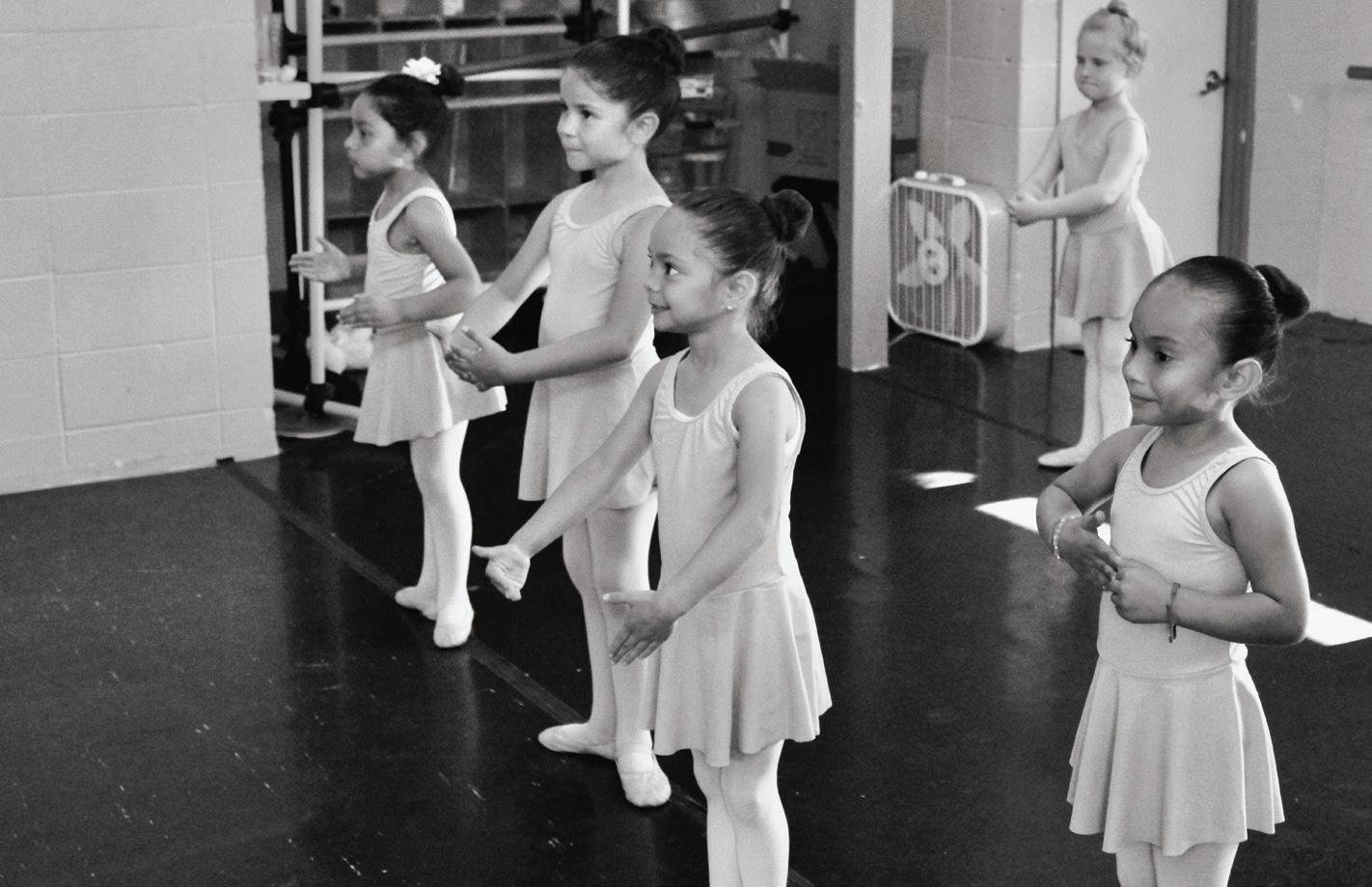
Growing up in the dance world, Palo Alto High School junior Kennedy Do always knew about the financial restrictions that stop many dancers from continuing to pursue their passion. As the president and founder of the nonprofit Dancers Donate, she collects gently used dancewear and donations to provide to under-resourced dancers so they can continue their dreams.
Founded in 2022, Dancers Donate partners with local dance studios in East Palo Alto and San Francisco, and has expanded internationally to studios in Nigeria, Vietnam and the Philippines.
“I’m just really hoping to help dancers in need,” Do said. “I know about so many underprivileged communities that could really benefit from new dance gear as well as donations.”
Dancers Donate collaborates with studions in San Jose and San
Francisco to order new supplies for studios with different needs.
“A lot of dance studios struggle to find uniforms for clothing that everyone has access to that’s also affordable,” she said. “I’ve been helping a lot with finding uniforms for everybody so that they have the opportunity to go to dance.”
The local dance studio Mannakin Theater and Dance established an outreach program in 2019 called En Avant School of Dance, located in East Palo Alto. They have received 75 pairs of dance shoes from Dancers Donate. According to Nathan Cottam, artistic director of Mannakin Theater and Dance, 56% of his students use dancewear provided from Dancers Donate. He said many of the families at his studio don’t have the financial means to pay the full price for ballet classes, so the donations from Dancers Donate are a big help.
“Every penny counts in this situation with these families; they pay about 60% of what somebody in another community would pay for ballet, which is a stretch for some of them,” Cottam said. “So if they had to buy dance clothing on top of that, it would stress them even further.”
Dancers Donate has opened up opportunities for dancers around the world, and local dancers at En Avant School of Dance. “Kennedy’s project, it’s one of the factors that helps make sure that the kids in East Palo Alto have similar opportunities as more wealthy families like in Palo Alto,” Cottam said.
Many people cannot proceed with their artistic passions because of financial means. Cottam said that it’s incredible what Dancers Donate does because they are trying to tackle this problem globally.
“What makes Kennedy’s work so special is that she’s taken the initiative to do something where there’s an opportunity to do good where effort is required,” Cottam said. “That’s the type of effort most people aren’t willing to do.” v
She [Do] has taken the initiative to do something where there’s an opportunity to do good where effort is required.”
— NATHAN COTTAM, studio director

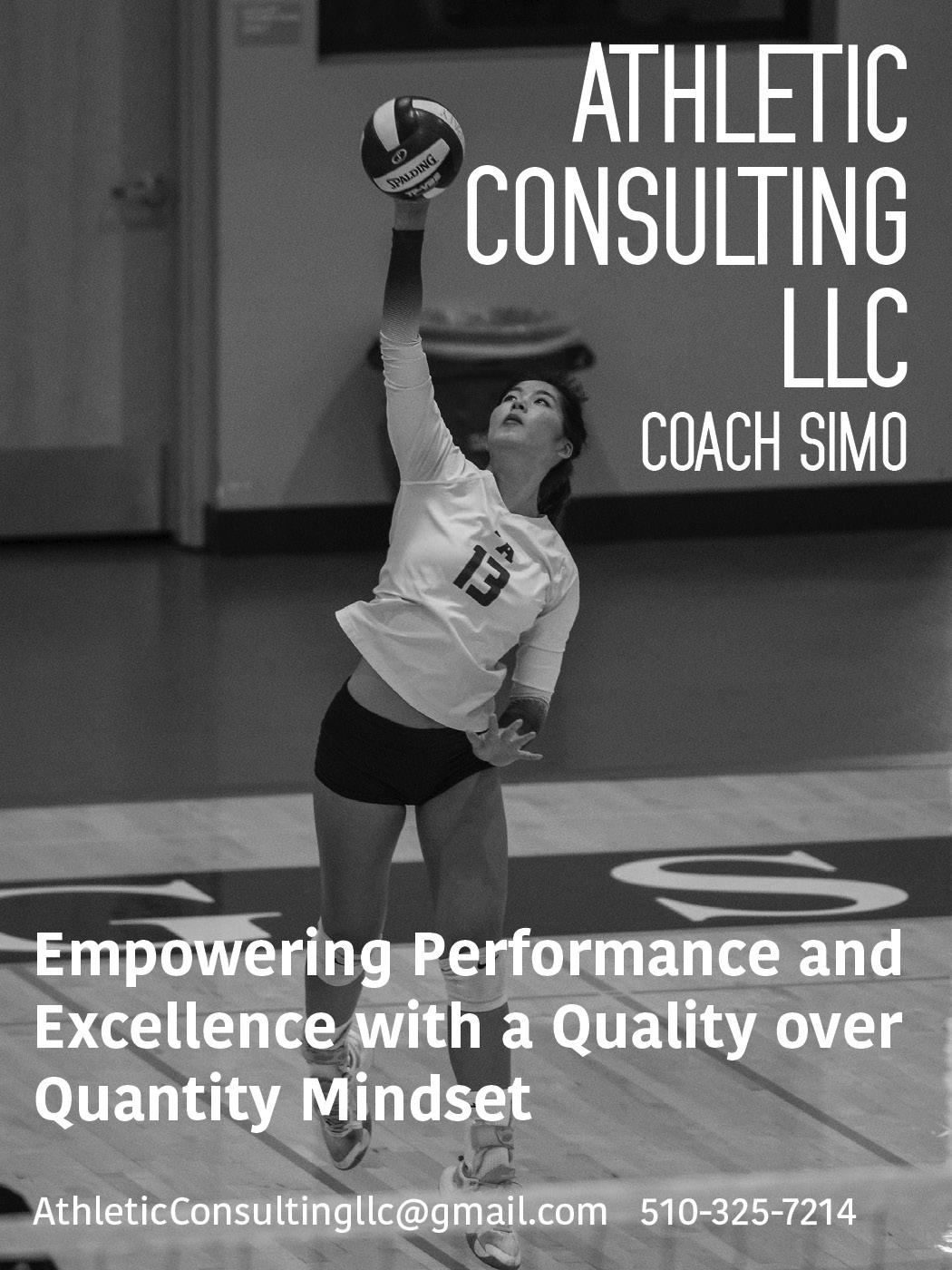

 Text by ELLA HWANG
Text by ELLA HWANG
SEVENTEEN. THAT’S HOW OLD OLIVIA Rodrigo was when “driver’s license,” her first single and the top streamed song of 2021, was released. Shortly after, her debut album “SOUR” broke the record for most songs in the top 10 at one time by a woman, according to Billboard. From Disney stardom in her earlier teen years to becoming a world famous pop star, Rodrigo has accomplished many feats at a young age. Now 20 years old, she has faced pressure to match her previous success with her anticipated sophomore album, “GUTS,” released on Sept. 8. In this album about growing up, heartbreak and the struggles of a 19-year-old, Rodrigo does not fall short of expectations. v






“Vampire,” the first single released from the “GUTS” album reflects a style similar to that in “driver’s license.” In the chorus Rodrigo demonstrates her signature melody of ascending notes. Fans speculate that Rodrigo uses the metaphor of a vampire to represent a toxic relationship she was in with someone older than her, using phrases like “You only come out at night” and “sunk your teeth into me.” This was the perfect song to release as a single to get fans excited for the coming album, as it showcased her strong vocal talents with her relatable-yet-heartbreaking lyrics.
Drastically different from her previous single, “vam pire,” the album’s second single “bad idea right?” starts off with Rodrigo speaking softly, which is immediately fol lowed by a groovy drumbeat. This is an upbeat track with light-hearted, sarcastic lyrics about going back to her ex. For the majority of the song, Rodrigo uses the talk-singing tech nique that she used in “brutal,” the first track of “SOUR.” Rodrigo channels her inner early-2000s style with this fun pop punk track.
“Lacy,” the fourth track of “GUTS,” contrasts many of Rodrigo’s other songs on the album with its acoustic, slower sound. She perfectly encapsulates a feeling of jealousy toward someone, acknowledging that she feels her mind is “rotten” for how much she wishes to be someone else. Much of the song is spent describing the perfections of this person, “lacy,” saying she has “skin like puff pastry” and “eyes white as daisies.” The lyricism in this song stands out, especially compared to some of her other songs which are more focused on beats and melodies.




Rodrigo alludes to the saying “you’ve made your bed, now lie in it,” in the heart-wrenching ballad “making the bed.” In this, the sixth track of her album, she discusses many aspects of her life she is unhappy with, explaining that she is the only one to blame, or, in her words, that it is her who has been “making the bed.” It starts off with an anticipatory ringing sound that gradually gets louder until she begins to sing. This song stands out because of the compelling melody and poetically melancholy lyrics.
Although some may prefer Rodrigo’s ballads to her rock tunes, “love is embarrassing,” the ninth track on the album, appeals to a broad audience because of its danceable beat. This upbeat and angsty tune starts off with her singing the verse in her lower register, reminiscent of 80s female rock bands like “Blondie.” In contrast, the very catchy chorus showcases her higher voice as she explains how embarrassed she feels to love “some weird second string loser who’s not worth mentioning.” This song is difficult to listen to without singing along.



“Will I spend all the rest of my years wishing I could go back?” Rodrigo asks this question as she describes her fears for her future career in the final track of the album. In the song “brutal” from “SOUR,” she asks “Where’s my f*cking teenage dream?” This is what she could be referring to in “teenage dream” with the lyric “And I’m sorry that I couldn’t always be your teenage dream.” She expresses worry that she could have peaked in her career and that she can’t live up to others’ expectations after the extreme success of her first album “SOUR,” especially at such a young age.


This is the deficit that TheatreWorks Silicon Valley, a Tony-award-winning theater company, expects in the next year due to falling ticket subscription rates. The 53-year-old Palo Alto-based nonprofit announced in August that if it doesn’t receive the funds it needs by November, it will not be able to complete its 2023–2024 season.
Artistic Director Giovanna Sardelli has noticed progress in the fundraising campaign.
“We are at 70-something percent of our goal and that’s [been] four weeks … over 400 donations have poured in from across the country,” she said.
But a significant deficit remains. And unfortunately, TheatreWorks is not alone in its financial difficulties. The arts service organization Theatre Bay Area reported that over 20 Californian theaters have closed or suspended production since 2020.
One of these theaters was the 19-year-old Bay Area Children’s Theatre (BACT), which closed in May due to rising operating costs. Khalia Davis, the former artistic director for BACT, said the closure came as a shock.
“I was upset because I felt like there was more we [BACT] could do,” Davis said. “I think the work that we were giving to the Bay Area community was something of value.”
Along with regional theaters across the country, BACT had to adapt their production style during the pandemic.
“What makes theater special is a shared experience together with other people in one space, watching something and being moved by it,” Davis said.
“When you remove the ability to gather together as a community in person, it stops that from happening. … So what we [BACT] had to do during the pandemic was pivot to other ways that we could be bringing the arts to homes,
Text by ASHA KULKARNIbringing the arts to the community, virtually, digitally and also through our audio series.”
TheatreWorks also produced shows in other mediums.
“We did more online programming than many theaters I know because we wanted to keep our artists involved,” Sardelli said.
A lack of in-person shows made it difficult for theaters to maintain an audience. But loyal patrons continued to attend productions, such as local resident Wynne Dobyns, who has gone to TheatreWorks for over 30 years.
“The plays are interesting,” Dobyns said. “The actors are top-notch. It’s local so we can easily get to it. And it’s more affordable than [going to] San Francisco.”
When TheatreWorks closed its doors during the pandemic, Dobyns attended shows on Zoom.
“I was really impressed with the way that they could coordinate the acting on various Zoom screens from the actors who were in their homes,” she said. “What I really liked about it is that it brought the arts to us when we couldn’t go out to them.”
According to Sardelli, adjusting to the pandemic was difficult for TheatreWorks despite the new skills the organization learned.
“We [theater staff] are used to working together and so the isolation was … emotionally challenging,” she said.
Uncertainty has remained, Sardelli said, even as TheatreWorks returned in person in spring 2021.
“We had a pretty robust subscription base [purchasers of tickets for seasons in advance] and then coming back from the pandemic … half of our sub-
scribers didn’t come back,” she said. “We kept thinking that number would increase steadily and it did, but not anywhere near what it was prior.”
Meghan Crosby-Jolliffe, the membership and community engagement officer for Theatre Bay Area, said that a loss of subscribers following the pandemic has been common across Bay Area theaters.
“They [audiences] are not coming back in the same amounts as quickly as people expected them to,” Crosby-Jolliffe said.
Additionally, Crosby-Jolliffe has noticed a decline in donations to nonprofit theaters.
“There’s a little bit of donor fatigue because people really gave a lot and from their heart during the pandemic to make things continue,” Crosby-Jolliffe said. Labor has also been difficult to find. According to the LA Times, California’s performing arts sector lost a decade’s worth of jobs in 2021.
“People … left the industry or left the Bay Area because it’s so expensive to be here and it’s just unsustainable if you don’t have income,” Sardelli said. “We’re rebuilding the pool of talent we had, both behind the scenes and onstage.”
To attract a wider audience, TheatreWorks seeks to widen its demographic profile.
“We’re looking at our commitment to everything in terms of diversity, in terms of age range, so that our shows appeal multi-generationally and multi-culturally,” Sardelli said. “So that if you look at the season at TheatreWorks, you go, ‘Oh, there’s lots of shows that seem
interesting.’”
For BACT, burnout from the pandemic took a toll, along with struggles to pay all theater staff.
“We did everything we possibly could to revitalize and come back after the shutdown,” Davis said. “It was always like rolling a rock up the hill.”
The Bay Area theater community hoped for a reprieve in late 2022, when the state legislature passed Senate Bill 1116 to establish a payroll fund for nonprofit arts organizations. But the bill has yet to be funded, which means that monetary help from the fund has not reached theaters.
“SB 1116 is supposed to create a support system for small nonprofit companies to more equitably pay the people that work for them,” Crosby-Jolliffe said. “So it’s a really big economic impact once it’s funded.”
With so many theaters taking a financial hit, the future of regional theater in the Bay Area is far from certain. What is certain for Crosby-Jolliffe is that the issue must be tackled.
“The Bay Area theater community is really vibrant and there is so much innovative theater that happens here,” Crosby-Jolliffe said. “If we don’t make sure that … theater is able to thrive here, I think we’d see the ripple effects across the country because so many big shows have gotten their start in development in the Bay Area.”
Davis recognizes that the problem may be too large for theaters to handle on their own.
“If we’re all struggling, then why aren’t we working together?” she said. “I’m hopeful that the future of theater here in the Bay is that we’re doing more collaboration, more partnerships, more theaters coming together and saying, ‘Let’s share our resources.’ … I really believe that togetherness is going to be the thing that will save us.” v
“ We did everything we possibly could to revitalize and come back after the shutdown.”
— KHALIA DAVIS, former artistic director of Bay Area Children’s Theatre
APINK FLUORESCENT SIGN READING “Boba is life” glows from its spot nestled among bright flowers that line the wall. Multiple areas around the store invite customers to take photos, including a giant bench in the shape of a mochi donut, a fluorescent boba cartoon and wallpaper with slogans like “Partea hard.” Customers sip their drinks at chic, white marble tables near the oversized rose planters that line the sidewalk.
This is the picturesque ambiance of Bober Tea and Coffee, which opened its doors July 29 at 121 Lytton Ave., bringing in new customers and returning fans of the popular franchise, which also has locations in Alameda, Sacramento, Stockton and Sunnyvale.
Arriving on an early Sunday morning, I visited this vibrant store to sample some of their most popular drinks.
The store had customers order on a kiosk, with options to add extra toppings like Brown Sugar Konjac jelly, Passion Fruit Popping Boba, crushed Oreos, pink honey boba and Chizu, a housemade sweet cheese cream.
The system was slightly confusing because most of the photos showed drinks with boba and other toppings, but the toppings
weren’t always included. Thankfully, the staff was very accommodating and friendly.
For example, they informed customers who accidentally ordered double the amount of toppings and offered refunds.
“The current generation is all about Instagram and photos so that [the decor] will definitely attract people to come,” said Palo Alto resident and customer Miriam Volerink as she admired the store.
Volerink has visited the store’s Sunnyvale location as well as this one.
She said that her young daughters especially enjoy the festive decor.
“They love how the store is decorated with the flowers,” said Volerink.
The drinks were decadent and equally tasty as they were aesthetically pleasing. Here are some drink-by-drink impressions. v

Part of the store’s Fresh Fruit Tea series, this drink came with a large slice of grapefruit and its pulp. The jasmine green tea added a nice flavor but left a slightly bitter aftertaste. Overall, the drink was a bit sour (as expected for grapefruit) and the sweetness level couldn’t be adjusted due to the store’s presets. It probably would’ve been more balanced if I had ordered it with the suggested passion fruit popping boba.

With edible 24-karat gold flakes sprinkled on a layer of foam, this latte was the fanciest drink I’ve ever tasted. The rich, caramel flavor completely masked the usual bitterness of traditional espresso in a latte. The texture was creamy, with a generous scoop of cookie butter on the bottom that had hints of cinnamon and a spice flavor similar to gingerbread. I had expected the taste of the drink to be overpowered by the cookie butter flavor, but it was subtle despite being slightly sweeter than the average latte.
This milk tea was creamy and sweet but lacked a strong hazelnut flavor. I added the Konjac Jelly that was featured in the picture on the menu for an extra 80 cents. Konjac is a root vegetable commonly used for its starchy bulb root. The jelly was delicious — its mellow flavor wasn’t as sugary as the brown sugar boba and complemented the honeyed flavors of the tea perfectly.

According to its employees, this is one of Bober Tea and Coffee’s most popular drinks. This black tea with milk is served in a cup coated inside with house-made brown sugar syrup and filled with warm, stir-fried brown sugar boba. A unique component of this drink is the housemade cheese cream and layer of caramelized brown sugar that tops the classic milk tea typically found at most boba shops. The cream has a creme-brulee-like texture and adds a nice touch of sweetness to the drink. The boba pearls have a perfect chewy texture but are much sweeter than others I’ve tried because they’re soaked in brown sugar.





THE MOMENT ONE STEPS THROUGH THE door, one is transported from loud and busy California Avenue to a quiet, dimly-lit space. To the left is the lounge area, complete with cozy couches and a low wooden table. To the right are large tables with appearances similar to a vertical slice a tree trunk and an organized bar. The friendly staff complete the atmosphere. This is Sekoya.
The restaurant, nestled between Ume Tea and La Boheme, formally opened on Aug. 10. Sekoya features California-style food with both European and Asian influences, as well as a sizable selection of alcoholic beverages. Sekoya is the first of its kind with no other locations, though owner Steve Ugur has opened other restaurants before.
Ugur said one of the goals for the restaurant is to be a unique community gathering place.
“We tried to create a nice neighborhood restaurant where people can come and enjoy food,” Ugur said. “You can come in three different times and have three different experiences.”
According to the its website, Sekoya “sets out to provide an experience that seamlessly delights each of the senses.” The restaurant offers five dining areas: the bar, front patio,enclosed terrace, lounge and Tree Tables for parties of six to eight.
Sekoya offers an “Amber Hour” Monday through Saturday from 4 p.m. to 5:30 p.m. in the bar and lounge dining areas. The Amber Hour comes with a unique menu that offers many of the regular items at a discounted price, though ordering from the full menu is still an option.
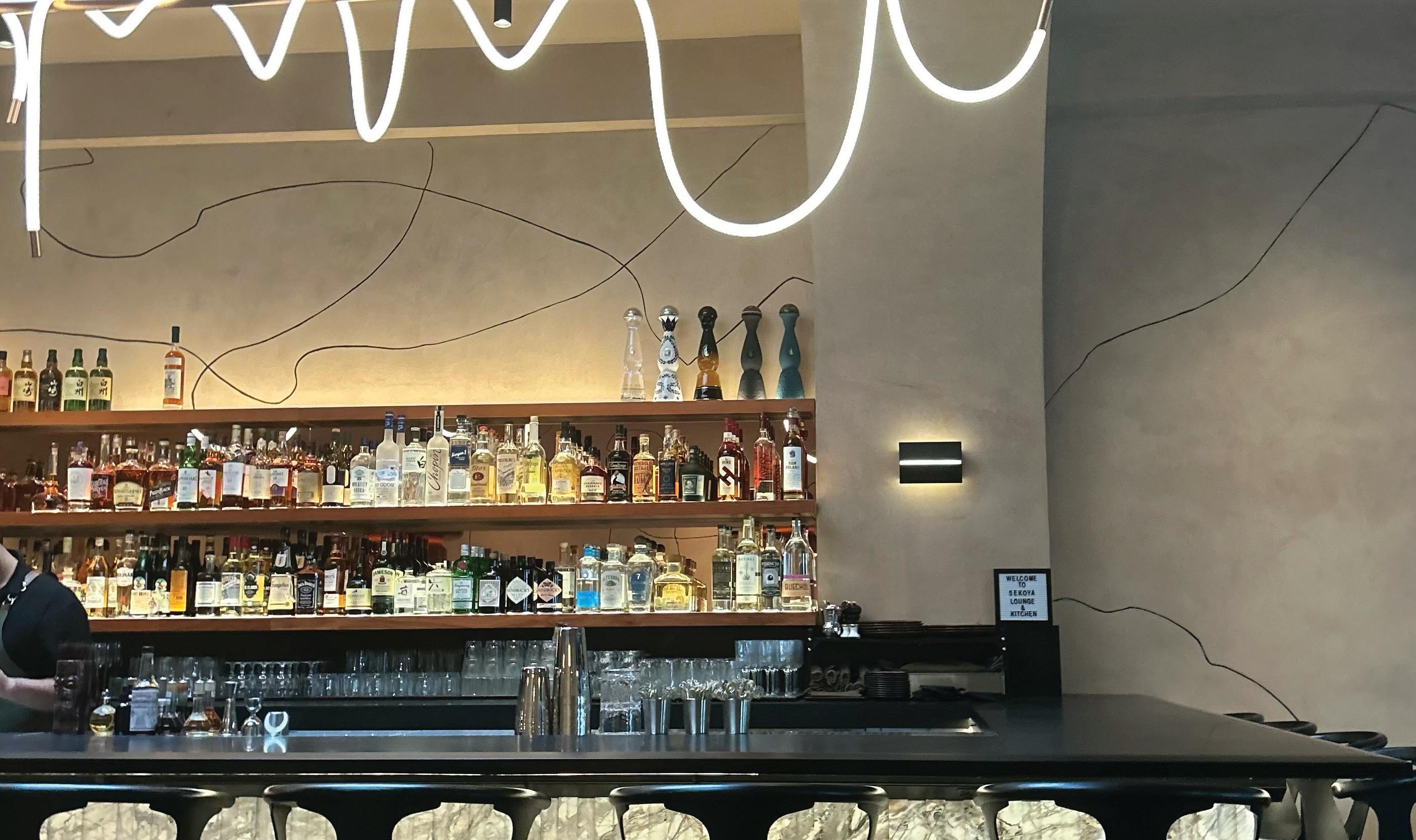
We sat down during Amber Hour to try Sekoya out. We arrived at 4:05 p.m., just after the restaurant opened Saturday evening when it was almost entirely empty. Here is what we found. v

$5 each ($3 during Amber Hour)
The first starter was two oysters topped with fresno chili-sangria mignonette, smoked trout roe and citrus pearls. The oysters were very refreshing, with both the roe and citrus pearls adding vivid bursts of flavor. The savory mignonette sauce contributed even further to the oysters’ natural oceanic flavor. The presentation was clean and simple and the oysters, delivered very shortly after ordering, were a perfect start to our meal.
$16 ($12 during Amber Hour)
The Double-Fried Tempura Mushrooms consisted of shimeji & maitake served with whipped tofu, yuzu, sweet soy, togarashi and chives. According to Ugur, this is one of Sekoya’s most popular dishes.


The mushrooms were flavorful and stayed crisp even after some time passed. Though we were initially skeptical about the whipped tofu, its creamy texture and mild flavor served perfectly balanced out the crunch and strong salty taste of the mushrooms. For those used to eating mushrooms cooked more traditionally, this dish takes a wonderful spin on them. However, the dish is certainly on the saltier side, so those who dislike that may want to steer clear.
$16 ($14 during Amber Hour)
The Spanish Octopus skewer came straight from a Hibachi grill. The texture was chewy but not rubbery and still juicy. Similar to the oysters, the skewer’s dual smokey and briney tastes combine to create a dynamic and delicious flavor profile. Note that the price tag is for one single skewer, and may not feed you as much per dollar as some of the other menu items.
$22 ($16 during Amber Hour)
The Dry Aged Smash Burger was the star of the show with two patties, smoked gouda, caramelized red onions and a savory Sekoya burger sauce, all between house-made sesame buns. Pickles were served on the side.

The burger was on the saltier side as were all the other starters and plates we tasted. The patties themselves carried a strong smokey flavor complimented excellently by the abundance of cheese and onions on top. The savory sauce tied all the individual flavors together. The sweet pickles did well to balance out the salty flavors.
$16
Last but certainly not least was the Strawberry Tres Leches Cake. The cake itself was firm, dense and on the drier side, but the super fluffy milk foam balanced it out well. The strawberries were tangy and a nice addition to the cake itself. All-in-all a very balanced dessert.
As a whole, dinner at Sekoya was a good experience with delicious food and relatively affordable prices. Those looking for a more elevated but not overly-formal dining location should absolutely try their luck.

CARBON CHARGING — Electric cars charge in front of Volvo Cars Palo Alto. Paly sophomore Arjun Jindal says that buying EVs is less about sustainability and more about preference. “Don’t buy an electric vehicle because you believe in sustainability, because lithium isn’t sustainably harvested,” Jindal said. “It’s more about whether you like the car.”
 Text and photo by EVA CHANG
Photo by Eva Chang
Art by JESLYN CHEN
Text and photo by EVA CHANG
Photo by Eva Chang
Art by JESLYN CHEN
IVE P.M.: THE LIGHTS begin to flicker. My hands fly to my laptop, rushing to send one last message as the power begins to go out. I am glad I was able to get some work done, but there’s no telling how long the outage might last. This is a routine that has become all too familiar.
Full electrification of homes, businesses and vehicles has become popular among California citizens. Up to 20% of California homes are fully electric as of 2022 according to the U.S. Energy Information Administration. But the frequent loss of power prompts one question that the community must ask itself: Are we ready to go all-in with electrification?
The City of Palo Alto has committed to fully electrifying homes, businesses and cars by 2030. While electric energy can be a great way to limit emission waste, there is one major issue we must tackle before prompting such a major change in our community: Fixing our infrastructure.
Across California, existing infrastructure is struggling to provide reliable energy. Heat waves and grid overloads have proven capable of bringing our electric systems to the brink of collapse, and even with the assistance of scheduled blackouts, thousands of Californians are still left without power for hours. Just last September, about 35,700 residents in Silicon Valley on at least one occasion were left without access to heat, water, or plumbing, according to CNBC. This pattern has become increasingly evident in recent years, with grid operators shutting down electric grids more than 50,000 times last year, affecting 51 million customers according to Bloom Energy. None of the shutdowns were for Public Safety Power Shutdown (PSPS) purposes, such as wildfire prevention according
to a 2022 report released by PG&E.
In fact, California currently imports energy from neighboring states, according to an article from Reuters. To meet increasing demands, California needs to achieve energy independence. We shouldn’t have to rely on other states in order to keep our own running. If the goal is to go full electric, the utilities departments must put sufficient infrastructure in place first so that people won’t have to worry about frequent outages.
According to Assistant Director Jonathan Abendschein from Palo Alto Utilities, Palo Alto’s Sustainability and Climate Action Plan proposes widespread grid modernization and investment in technology to improve grid reliability.
“It [the plan] is replacing aging infra structure,” Abendschein said. “It’s making investments in technologies and grid con figurations that improve our reliability in the future, and it’s going to systematically increase our grid capacity in places where we need it.”
Still, the transition to full electrifica tion will not be an easy one. Abendschein estimates that improving Palo Alto’s grid capacity will cost hundreds of millions of dollars. Implementing full electricity across California will likely cost even more.
Transportation is another system that will be heavily impacted by the push to achieve full electrification. Proposals such as California’s recent Advanced Clean Cars II rule, with a goal to only have zero-emis sion cars sold in the state by 2035, will re quire a reliable grid system.
How can the community expect the grid to support the increased load from charging so many electric vehicles if our current grids can’t even handle the increas
ing presence of severe heat waves? One example was the Flex Alerts issued during September 2022, which encouraged Californians to conserve power in order to avoid grid shutdown according to NBC.
The cost of full electricity will also be primarily felt by the people. A study conducted by EnergySage found that the average Californian already pays 33% more in electric bills than the national average. With the additional load required for electrification by 2030, everyone will see increased bills because the costs of heavy electrical improvements will be passed onto us. To keep electric energy a viable and appealing option, the government needs to recondition our infrastructure so that people are supported while the transition to full electricity is being made.
Clean electric energy is the future. Still, it’s important to pay just as much attention to updating our infrastructure as it is to begin the transition to full electrification. I implore Californians and our state legislature to reconsider current electrification

Clean electric energy is the future. Still, it’s important to pay just as much attention to updating our infrastructure as it is to begin the transition to full
.
AS I STEPPED OUT of the car at Palo Alto High School before the first football game of the season, I hesitated for a moment.
What if our stunts fall? What if someone gets hurt? However, as I tried to come up with answers to these questions, I came to a realization: Despite the inevitable what-ifs, I didn’t feel nervous at all.
I wanted to perform well for myself and my team, but for what felt like the first time in my high school career, I wasn’t focused on what other people were going to think about me.
I felt so calm getting out of the car that day, it was almost anxiety-inducing.
I joined cheer my sophomore year because the past two years of my life had revolved only around school, and I was in a place of desperation. I was longing for something that would get me up in the morning.

Having goals to work towards and people who supported me took my mind off of school and my home
life, getting me through the end of the year.
After joining, I quickly became close with my team.
The intense practices, thrilling performances and endless support from teammates created long-lasting friendships that have extended both on and off the mat and field.
“It’s incredibly rewarding to witness their [the cheerleaders’] dedication, teamwork and determination as they master new skills and come together as a tight-knit squad,” coach Lea Santini told me. “The bonds we create and the sense of pride they feel during performances make all the hard work worthwhile.”
So when people ask ‘Why cheer?’, it sometimes confuses me.
I find myself thinking, why not cheer?

I get it – I really do. Living in a society that objectifies women for almost anything has left many, including myself, wondering if the sport does just that, and questioning its purpose.
Media portrayal of cheerleading has especially fed into misconceptions that emphasize stereotypes, and generate the idea that the sport is exclusively tailored for an exclusive group of snobby girls who walk
Textwith their noses in the air.
But when people choose to focus on the non-athletic aspects of cheerleading, such as the uniforms or media representation, it dehumanizes cheerleaders and undermines the reputation of the sport as a whole.

“People only see the sparkly pom poms and the uniforms,” co-captain Lily Jefferey said. “They don’t see the physical work that goes into the sport.”
“In reality, modern cheerleading is an intense sport that requires a high level of physical fitness, strength, flexibility, and coordination,” Santini said.
So when classmates shoot dirty looks at my uniform, question the morals of cheerleading, or insinuate it isn’t even a sport to begin with, I remind myself of all the things cheer has instilled in me. I remind them how it’s shaped me into the person I am today, and why I continue to stay.
When people say ‘It just doesn’t seem like you,’ I don’t tell them “Actually, my true passion is yelling P-A-L-O-A-L-T-O for a mainly unresponsive student section,” or “You’ve got it all wrong, waving my poms to the backs of stern-faced


football players empowers me.”
I instead find myself defending the sport, wondering what is so hard to believe.
I’ll tell them that participating in cheer has brought out the extroverted side of me that I had suppressed for so long I didn’t even know it was there.
I’ll tell them about the rush of adrenaline and excitement after my group and I finally master a new stunt.
About how much I’ve grown athletically and as a person and the amount of support I’ve received from my team along the way.
I’ll tell them how it’s impos sible not to smile as soon as I step out on to the field.
I’ll describe how the world seems to hold its breath with me while the stadium lights flicker on.
I’ll struggle to articulate the feeling that I am exactly where I am supposed to be.
That for once, I’m not worried about standing out, because that’s exactly what I’m going to do.
And when the sun dips below the horizon and the music starts, I feel more like myself than I have in years. v
“
People only see the sparkly pom poms and the uniforms; [they] don’t see the physical work that goes into the sport.
— LILY JEFFREY, cheer co-captain
EXPERIENCED more like 110 degrees with the humidity. Grabbing
As we looked at each other, we laughed to make light of the situation because that’s all we could do.

laughed to make light of the situation because that’s all we could do.

I look out at the thousands of tents lined up, grab my water bottle and start the quarter-mile walk to the nearest water foun-


I spent three days at the World Scout Jamboree in Saemangeum, Korea, an event hosted every four years in a different country each year, with 43,000 different scouts from 156 countries. During my time there I received at least 150 notifications from Korean public health services to stay indoors due to the heat wave and an in-
According to the Korean government, hundreds of people at the campgrounds suffered from heat-related ailments, overwhelming the singular hospital at the site. The feeling of hopelessness was felt throughout the campsites. With the minimal transportation available for everyone, our only option was to push through this eight-day event hoping for rescue.
As the typhoon got closer, the US contingent decided to evacuate to the largest foreign military base, United States Army Garrison-Humphrey, as the campground was not built to survive a typhoon. With the need to evacuate 43,000 people in a matter of days, many scouts stayed in university dorms, hotels and even overflowed hostels.
Coming back to Palo Alto this fall, I could feel a shift in the weather from previous years, some days
Text by AUGUSTUS SOEDARMONOthe past years, the average peak temperature has increased from 75 F° to 78 F° with numbers reaching to the 90s, while in 2022 the temperature reached the highest of 82 F°.
Seeing on the news that California was getting hit by a tropical storm — which hasn’t happened since 1939 — reinforced the notion for me that climate change is here

ters have incurred over $12 billion dollars in damages since 2000.
These trends show us that climate change not only affects our health, but also takes a huge financial toll.
Coming back from Korea, my perspective heavily changed on the status of climate change. From living in the California weather — pleasant and sunny most of the time

more on my part to help climate change.
I found myself gravitating towards choosing more eco-friendly options, grabbing my bike instead of keys to my car.
We’re already noticing this from the increase in temperature and natural disasters.
The question in the end is: should we care about climate change? Are we actually willing to do the little things to help our world? The answer is we should. Like cli

 Art by JESLYN CHEN and KIARA TAVAKOLI
Art by JESLYN CHEN and KIARA TAVAKOLI
Climate change is here and is not stopping anytime soon.
Palo Alto Unified School District
Palo Alto High School
50 Embarcadero Road
Palo Alto, CA, 94301
